
U.S. Government Accountability Office

Small Business Innovation Research: Better Data and Clarity on Eligibility of Venture Capital-Owned Businesses Are Needed
Agencies make Small Business Innovation Research awards to help small businesses bring their technologies to market. In this Q&A report, we review agencies' awards to businesses owned by venture capital firms, hedge funds, or private equity firms.
These awards increased substantially in FYs 2021-2023—largely due to awards from DOD. But DOD found reliability issues with its data on such firms, so the extent of the increase is unknown.
And some agencies may not understand when small businesses owned by these firms are eligible for the program.
We made related recommendations to DOD and the Small Business Administration, which oversees the program.

What GAO Found
For decades, the Small Business Innovation Research (SBIR) program has provided federal funding to small businesses for technology development and commercialization. In fiscal year (FY) 2022, the 11 participating federal agencies made over 5,000 SBIR awards to small businesses valued at nearly $4 billion. In 2011, Congress amended the Small Business Act to give participating agencies the authority to make SBIR awards to certain small businesses that are majority owned by multiple venture capital operating companies (VCOC), hedge funds, or private equity firms (i.e., "qualified small businesses"). Agencies that use this authority must first submit a written determination to the Small Business Administration (SBA), which oversees the SBIR program, and certain congressional committees. Four agencies have used this authority to include qualified small businesses in their SBIR programs.
Only two of those agencies—the Departments of Defense (DOD) and Health and Human Services—made SBIR awards to qualified small businesses in FY 2021 through 2023. Despite this, the number of awards to such businesses and the dollars awarded to qualified small businesses appear to have increased substantially compared to the prior 6 years. The increase is largely due to Air Force's use of the authority beginning in FY 2021. However, the full extent of the increase is unknown; as a result of GAO's review, DOD uncovered reliability issues with the data used to identify its SBIR awards to qualified small businesses. DOD is taking steps to address data reliability, but these steps did not include processes to monitor the effectiveness of its efforts. Without quality data, DOD may report inaccurate information to SBA and may have difficulty meeting requirements to track its use of the authority to make awards to qualified small businesses.
Most agencies in the SBIR program have not used the authority to make SBIR awards to qualified small businesses. However, GAO found that some of these agencies may be inappropriately excluding some small businesses owned by VCOCs, hedge funds, or private equity firms that are eligible to participate in their SBIR programs without the agencies submitting a written determination to SBA and Congress. SBA updated its regulations in June 2016 and made other efforts to clarify eligibility rules for such businesses. Nonetheless, not all agencies were aware of the information SBA provided or fully understood VCOC-owned companies' eligibility, and officials from some of the agencies said eligibility issues related to small business ownership are potentially confusing. Without fully understanding the eligibility of companies owned by some VCOCs, hedge funds, or private equity firms, agencies may continue to inappropriately exclude certain companies from applying for and potentially receiving awards—contrary to SBIR program regulations and SBA guidance.
Why GAO Did This Study
Small businesses have been a major source of technology development in the U.S. economy but can face challenges obtaining the funding and investment needed to fully develop and commercialize their technologies. The SBIR program was established to increase the participation of small innovative companies in federally funded research and development. Eleven participating federal agencies make SBIR awards to small businesses. To qualify for awards, businesses must meet certain ownership and other eligibility criteria. The Small Business Act, as amended, authorizes agencies to allow participation in their SBIR programs by qualified small businesses.
The Small Business Act includes a provision for GAO to conduct a study of agencies' use of this authority and submit a report to Congress every 3 years. GAO's previous reports covered FY 2013 through 2020. This Q&A report, the fourth report in the series, provides information from FY 2021 through 2023 on the extent to which the 11 agencies in the SBIR program have elected to include qualified small businesses and the factors that have influenced these decisions.
GAO reviewed agencies' data on SBIR awards to qualified small businesses from FY 2021 through 2023, analyzed SBIR solicitations and other documents, and interviewed SBIR program officials from SBA and the 11 participating agencies.
Recommendations
GAO is making two recommendations, one to DOD and one to SBA. GAO is recommending that DOD monitor the effectiveness of its efforts to address the reliability issues in its data used to identify DOD's SBIR awards to qualified small businesses. GAO is recommending that SBA take further steps to ensure that all agencies understand the eligibility of small businesses with differing levels of VCOC, hedge fund, or private equity ownership to participate in SBIR. DOD agreed with our recommendation. SBA disagreed with our recommendation, stating it already clarified eligibility in this area. However, we maintain that further steps are still needed to ensure all agencies fully understand the SBIR program regulations and do not inappropriately exclude eligible businesses.
Recommendations for Executive Action
| Recommendation | ||
|---|---|---|
| Department of Defense | The Secretary of Defense should ensure that the DOD SBIR/STTR Program Office in OUSD(R&E) or other appropriate entity monitors the effectiveness of the recent efforts to improve the quality of the data used to identify its SBIR awards to "qualified small businesses" (awarded under 15 U.S.C. § 638(dd)), including through periodic evaluations of the accuracy of DOD's data in identifying awards to such businesses. (Recommendation 1) | |
| Small Business Administration | The Administrator of the SBA should take steps—such as clarifying the SBIR policy directive or eligibility guide or suggesting model language for SBIR solicitations—to ensure that all agencies participating in the SBIR program fully understand the eligibility of small businesses with differing levels of ownership by VCOCs, hedge funds, or private equity firms. (Recommendation 2) |
Full Report
Gao contacts.
Candice N. Wright Director [email protected] (202) 512-6888
Office of Public Affairs
Sarah Kaczmarek Managing Director [email protected] (202) 512-4800

An official website of the United States government
Here’s how you know
Official websites use .gov A .gov website belongs to an official government organization in the United States.
Secure .gov websites use HTTPS A lock ( Lock A locked padlock ) or https:// means you’ve safely connected to the .gov website. Share sensitive information only on official, secure websites.
- Science and Technology
- Work with S&T
- Innovation Funding Programs
Small Business Innovation Research Program

Upcoming Events
Office of Small and Disadvantaged Business Utilization (OSDBU) Vendor Outreach Session (VOS) — August 22
Join our next VOS with Small Business Specialists and Prime Contractors on August 22, 9:00 a.m. – 12:15 p.m. ET. Meeting requests open August 8. Schedule your VOS by visiting the Small Business Vendor Outreach Sessions webpage .
DHS SBIR is proud to announce the launch of Phase 0, a program that can help potential applicants understand the submission process, provide access to assistance resources for new applicants and collaborate with individuals committed to diversifying the science and engineering workforce.
Now through January 2024, the Phase 0 program will offer the following series of webinars focused on providing more information about the 24.1 solicitation cycle:
- How a Small Business Should Approach Understand the Pre-Solicitation
- Mandatory Federal Registrations
- Confirming Eligibility and Using Your Time Wisely
- How to Prepare a Responsive Technical Proposal
- Principal Investigators and Other Personnel
- Preparing Your Budget
- Protecting Your Intellectual Property
- Important Forms to Submit with Your DHS Proposal
- DHS SBIR Proposal Submission Process
These webinars are recommended for all innovative R&D small companies interested in learning more about the SBIR program and process. Register here for the Phase 0 webinars.
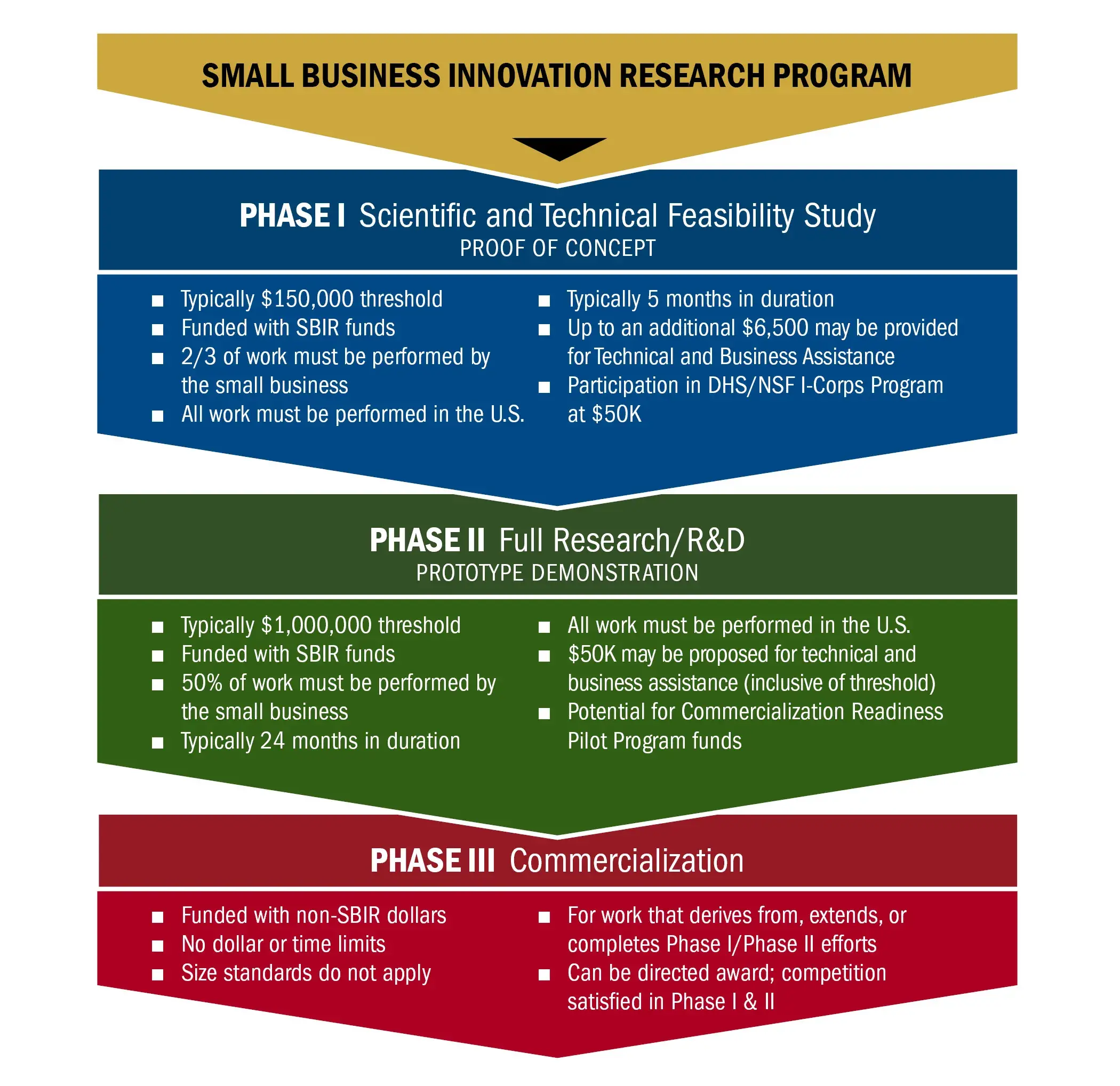
Phase I typically funds up to $175,000 for five months to determine the scientific and technical merit, and feasibility, of the proposed effort. Phase I awards are typically made within 45 days after selection.
Phase II typically funds up to $1,500,000 for 24 months to continue the R&D effort from the completed Phase I project and work towards a prototype demonstration. Only SBIR Phase I awardees are eligible to participate in subsequent phases. Options may be exercised for S&T SBIR Phase II projects that have firm commitments for follow-on funding.
Phase III is funded from a private or non-SBIR government source for commercialization or continued development and testing from an effort made under prior SBIR funding. Phase III work is typically oriented toward commercialization of an SBIR effort which can include products, production, services, research and development or any such combination. Phase III has no limit on the number, duration, type or dollar value of awards made to a small business. There is also no limit on the time that may elapse between a Phase I or Phase II award and a Phase III award, or between a Phase III award and any subsequent Phase III award.
SBIR Success Stories
We are committed to identifying promising small businesses and innovative approaches to help address homeland security needs. Our success stories highlight companies that have made lasting impacts to our nation with successful technological innovations through the DHS SBIR Program. These examples showcase a number of small businesses from around the nation that have worked with S&T to develop and support the technology needs of our nation and homeland security end-users. Read our DHS SBIR success stories !
Deconstructing SBIR Video Series
Watch our videos explaining the SBIR process:
- Detecting Trapped Survivors OATS RFI
- Insights Outreach | Getting Onboard with SBIR
- What's New in 2022!
- 2021 Other Agency Technology Solutions (OATS) RFI
- Planning for Privacy
- Innovate S&T: SBIR Proposal Submission Process
- Innovate S&T: Making the Most of Your One-on-Ones
- SBIR One-on-One Dos and Don'ts
- SBIR 20.1 Solicitation
- SBIR 21.1 Pre-Solicitation
- TechTalk: Small Business Innovation Research Program
- DHS Announces New 24.1 Small Business Innovation Research Pre-Solicitation - November 15, 2023
- DHS Awards $14.9M to 15 U.S. Small Businesses for R&D Prototypes - August 29, 2023
- DHS Awards $3.15M to 20 U.S. Small Businesses for Proof-of-Concept Research - July 6, 2023
- DHS Opens 23.1 Small Business Innovation Research Solicitation - December 19, 2022
- DHS Announces New 23.1 Small Business Innovation Research Pre-Solicitation - November 18, 2022
- DHS Awards $9.8M for Small Businesses to Develop Security Technology Prototypes - June 30, 2022
- DHS SBIR to Host First Responder Technology Showcase - March 22, 2022
- DHS SBIR Seeks Solutions to Detect Survivors in a Building Collapse - February 7, 2022
- DHS S&T Announces Small Business Innovation Research Pre-Solicitation - November 22, 2021
- DHS Awards $1M to California Small Business for Soft Targets and Crowded Places Security Solutions - October 6, 2021
Solicitation Details
The DHS SBIR Program issues an annual solicitation with topics that cover DHS mission areas for which proposals are sought. Topics for solicitations are solicited by S&T and CWMD and address the needs of DHS Operational Components including the Federal Emergency Management Agency, Cybersecurity and Infrastructure Security Agency, Transportation Security Administration, U.S. Citizenship and Immigration Services, U.S. Coast Guard, U.S. Customs and Border Protection, U.S. Immigration and Customs Enforcement, and U.S. Secret Service—as well as first responders. As such, the solicitations typically consist of topics relevant to the following organization focus areas:
- Borders and Maritime Security
- Chemical and Biological Defense
- Critical Infrastructure and Resilience
- Cybersecurity
- Explosives Detection and Aviation Screening
- First Responders
- Unmanned Aerial Systems
- Detecting Bioterrorism
- Technical Capability Standards for Radiological Detection
SBIR Program Portal
To learn more about the DHS SBIR Program and current solicitations please visit the SBIR program portal .
For more information about the SBIR program, contact the Program Director at [email protected] .
For more information about CWMD’s SBIR program, contact the Program Manager at [email protected] .

An official website of the United States government
Here's how you know
Official websites use .gov A .gov website belongs to an official government organization in the United States.
Secure .gov websites use HTTPS A lock ( Lock Locked padlock ) or https:// means you’ve safely connected to the .gov website. Share sensitive information only on official, secure websites.

In This Section
- Doing Business with DOI
- Small Business Specialists
- Small Business Accomplishments
- Small Business Innovation Programs
- DOI Industry Day Resources
- Small Business Resource Booklet (English)
- Small Business Resource Booklets (Spanish)
- System for Award Management (SAM)
- Contracting Opportunities
- Federal Acquisition Regulation (SB Program)
- Small Business Administration (SBA)
- Small Business Intelligence Tool
- X (formerly Twitter)
Small Business Innovation Research Programs (SBIR)
The SBIR Program was established by Congress in 1982 to fund research and development (R&D) by small businesses of 500 or fewer employees. The STTR Program was established in 1992 to fund cooperative R&D projects with small businesses and non-profit U.S. research institutions, such as universities. Eleven federal agencies participate in the SBIR program, of which five participate in the STTR Program (*).
- Small Business Administration ,
- Department of Agriculture ,
- Department of Commerce ,
- Department of Defense *,
- Department of Education ,
- Department of Energy *,
- Department of Health and Human Services *,
- Department of Homeland Security ,
- Department of Transportation ,
- Environmental Protection Agency ,
- National Aeronautics and Space Administration *, and the
- National Science Foundation *.
Each agency administers its own program within guidelines established by Congress in the Small Business Act and by SBA in the STTR/SBIR Policy Directive . These agencies designate R&D topics in their solicitations and accept proposals from small businesses. Awards are made on a competitive basis after proposal evaluation. The Small Business Administration’s Office of Investment and Innovation and SBIR/STTR Program website provide additional information regarding the SBIR/STTR programs.
Was this page helpful?
This page was not helpful because the content:
Please provide a comment

Learn if your company is eligible for NIH SBIR or STTR funding, how to apply , and what to expect during each step of the application process. Multiple registrations are required to prepare your application and apply for funding.
Understanding SBIR and STTR
Eligibility criteria.
- Grants Policy
- Foreign Disclosure and Risk Management
- SBIR and STTR Grants (NOFO s )
- SBIR Contract Solicitations
- Commercialization Readiness Pilot (CRP)
- Supplemental Funding to Diversify the Entrepreneurial Workforce
- Small Business Transition Grant for New Entrepreneurs
- Applicant Assistance Programs
- How to Apply
- Transition Award (Coming Soon)
Our team can help you maximize the benefits from NIH programs and resources which help you bring your innovations to life.
- TABA Funding
- TABA Needs Assessment
- Intellectual Property
- Pitch Coaching
- Reimbursement
- SOW Development
Explore training programs open to innovators interested in entrepreneurship.
The NIH is actively turning discovery into health by helping small businesses develop innovative technologies that improve health and save lives. See how .
- Search Technologies from Academic Centers and Hubs
We value diverse perspectives in biomedical innovation and strive to empower scientists and entrepreneurs to bring their discoveries to patients.
- Contact the SEED Team
- Who to Contact and When
- HHS Small Business Program Managers
Understand the basics of the Small Business Programs, including:
- Comparing SBIR and STTR
- Different funding paths and phases of the program
- Budget and timelines for funding
- Eligibility criteria
- Foreign disclosure and risk management

The Small Business Innovation Research (SBIR) and Small Business Technology Transfer (STTR), collectively the Small Business Programs, are also known as America’s Seed Fund. By setting aside more than $1.4 billion from its Research & Development Funding specifically for our Small Business Programs, the NIH provides support to early-stage small businesses throughout the nation.
Many companies leverage NIH funding to attract the partners and investors needed to take an innovation to market. We focus on a variety of high-impact technologies ranging from research tools to diagnostics, digital health, drugs, medical devices, and others. The NIH SBIR and STTR programs can provide the seed funding you need to bring your scientific innovations from the bench to the bedside.
The goals of our program are to:
- Stimulate technological innovation
- Meet federal research and development needs
- Increase private sector commercialization of innovations developed through federal R&D funding
- Foster and encourage participation in innovation and entrepreneurship by socially and economically disadvantaged (SDB) persons and women-owned small businesses (WOSB).
Watch this webinar recording from July 2024 to learn more about the NIH Small Business Program.
Our staff is equipped to guide you through every part of the process to maximize success. Without taking any ownership of your small business, the NIH provides funding for the research and development of innovations and supports commercialization efforts for your product. It is important to note that the NIH is generally not the final purchaser of technologies generated through the programs. View our Program Descriptions for more information.
Comparing the Small Business Programs - SBIR and STTR
Although the scope of the work is the same, there are a few critical differences between the SBIR and STTR regarding whether partnerships with a non-profit research institution are allowed (SBIR) or required (STTR). The money always goes to the small business.
| 3.2% | 0.45% | |
| Research partnerships are allowed | Partnership with a non-profit research institution is required (e.g. university) | |
Small businesses may outsource: | Minimum work requirements: The remaining work may be done by either or outsourced | |
| Primary employment (> 50%) should be with the small business | PI must be employed by either the partnering research institution or small business | |
We Have Several Funding Paths Within the Small Business Program Phases at NIH
Our programs provide funding based on milestones achieved during given phases. Please note that the NIH Small Business funding phases are separate from and not aligned with clinical trial phases. Below is an overview of application types within NIH Small Business phases that fund research and provide commercialization support.
You can begin with either a Phase I, Fast Track, or Direct to Phase II. Which path you choose depends on the amount of preliminary research and technology development you have done in advance of applying to NIH. Reach out to program staff to discuss which path is right for your small business.
| A Phase I award helps you focus on the feasibility, technical merit, and commercial potential of your research project. | |
| A Phase II award lets you continue the research and development efforts initiated in Phase I. Once you’ve reached your Phase I milestones, you can apply for a Phase II award, even before the end of the Phase I award. You may submit your application for a Phase II award up to six receipt dates after your Phase I budget period expires. | |
| The Fast-Track process allows you to submit both Phase I and Phase II in one application for review. The Fast-Track mechanism can minimize the funding gap between phases but requires a fully developed Phase II application/plan at the time of submission. | |
| If your project has already demonstrated feasibility, but you have not received a Phase I SBIR or STTR, you can apply for a Direct to Phase II award and bypass Phase I. | |
| Some NIH Institutes and Centers offer Phase IIB awards for Phase II projects that require extraordinary time and effort beyond the standard Phase II period of 2 years. Refer to our for more information. | |
| The Commercialization Readiness Pilot (CRP) Program provides awarded Phase II and Phase IIB small businesses technical assistance and funding for late-stage development. Read more about the . |
Budget and Timelines for Funding
The budget guidelines are the same for both programs, but individual NIH Institutes and Centers can set their own budget limits.
- A Phase I budget is $306,872 for a project timeline between 6 months to 2 years.
- A Phase II budget is $2,045,816 for a project timeline between 1 to 3 years.
We recognize that some biomedical innovations require additional funding to reach the marketplace. For those topics, the NIH has a waiver from the Small Business Administration (SBA) to allow larger awards. Please refer to a list of SBA approved waiver eligible topics .
Applicants are strongly encouraged to contact program officials before submitting any application in excess of the total award amounts listed above and early in the application planning process.
NOTE: The Tax Cuts and Jobs Act of 2017 included major changes to section 174 of the Internal Revenue Code that took effect in 2022. These changes require businesses to amortize R&D expenses over a five-year period instead of deducting them in the year they were incurred. Although federal income/excess profits taxes are strictly not allowable charges to NIH awards, either as direct or indirect costs. (see FAR 48 CFR 31.205-41), SBIR and STTR application budgets may include a “fee” that may be used by the small business for any purpose, including payment for a tax liability. See the NIH GPS Section 18.5.4.2 “Profit or Fee” for more information.
NIH staff cannot provide tax guidance. Small businesses that receive SBIR or STTR funding should seek guidance from the IRS or a trusted tax/accounting advisor on how this change may affect them.
View additional Frequently Asked Questions (FAQs) on SBIR and STTR budgets .
Learn which criteria are evaluated for your business to be eligible for the small business programs and other considerations NIH takes into account.
Support for Awardees
We also offer a variety of support and resources, including Technical and Business Assistance (TABA), at each application point. Explore our support for awardees .

Financial support from the NIH as part of their SBIR program was very much a critical component to the early start of this company [and] it continues to be a component of our success.
The NIH SBIR program has been invaluable. There'd be no other way that this would have been an option to provide to the autism community.
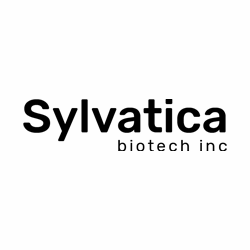
[The SBIRs] have allowed us to pursue new ideas and approaches to solving this long-standing problem of organ shortage.
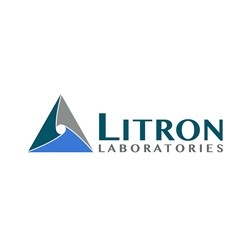
Litron Laboratories’ rate of innovation would not be possible without the benefit of SBIR funding.

The SBIR program is significantly important for disseminating, not just information, but actual interventions, especially for underrepresented populations.

[NIH small business funding] gave us the preliminary data that allowed us to approach investors and Big Pharma to fund the amount needed to move into phase two and phase three.

The grant gave us the funding to hire curriculum writers, to pay teachers to do pilot testing of the kits, and to go to science education conferences and present the kits; it gave us money to pay stipends for teachers who wanted to hold their own workshops, and money to provide the kits for the workshop. It really allowed the company to grow much more dramatically.
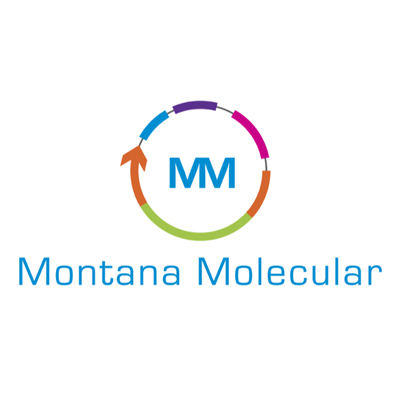
[SBIR] funding was absolutely critical to getting us off the ground.

Our very first funding came from the NIH. The origins of our success came from an NIH-funded project, and since then, we have been able to build on and expand our knowledge and tackle other pollutants.

We’re staunch supporters of this program. If anyone asks me about the NIH Small Business program, I give them nothing but encouragement to apply.

We were awarded a $1.5 million Phase II Small Business Innovation Research (SBIR) grant from the National Institute of Neurological Disorders and Stroke in 2018. That grant came at a time when follow-on funding was uncertain, and it allowed us to accelerate the development process and cover critical commercialization costs for our novel, bioabsorbable surgical clip. We’ve since focused our energy and resources on bringing this technology to market sooner, which will ultimately benefit patients and improve public health. I would love to see more Native American representation in the SBIR program. Including entrepreneurs from different backgrounds is key to solving “unsolvable” problems and is critical to forging new paths in science and healthcare.

In terms of venture capitalists for minority businesses, it is a really unfair playing field. So, the fact that SBIR funds minority businesses like ours is huge because otherwise, we would not get any investments.

This funding allowed me to achieve a scientific breakthrough and now I can talk about early detection, and I can talk about cancer, fibrosis, and changing the industry.

Stay in the Loop
Subscribe to our mailing list for updates on deadlines and important information.
- Small Business Funding
- Product Development Support
- Entrepreneurial Training
- Resources and Events
Fraud, Waste and Abuse
- Report Fraud
HHS Vulnerability Disclosure | Technical Issues: E-mail OER Webmaster

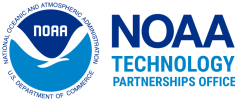
NOAA’s Small Business Innovation Research Program

Funding Opportunities
Resources for applicants, sbir successes.
The Small Business Innovation Research (SBIR) program is a highly competitive merit-based grant program that encourages U.S. small businesses to engage in federal Research/Research and Development (R/R&D), with the end goal of developing innovative and commercially-viable products or services. Including qualified small businesses in the nation’s R&D arena stimulates high-tech innovation. The United States gains entrepreneurial spirit as it meets its specific research and development needs.
NOAA’s SBIR is focused on developing products and services across our mission areas. The links below will help prospective applicants become more familiar with NOAA’s varied and important mission. Please explore the links below and the SBIR section of our website for all the information you will need to submit your application to NOAA’s next SBIR funding opportunity.

Climate and Weather
- Climate program and research areas
- Weather programs and research areas
- Severe Storms and Hurricane Research
- Earth System Research and Fluid Dynamics Research and Modeling

Oceans, Coasts, and Fisheries
- Fisheries Research and Aquaculture Program
- Global Ocean Monitoring and Observing Program
- Ocean Exploration and Research
- Oceans and Coasts
- Great Lakes Environmental Research
- Atlantic Ocean , Pacific Ocean Research
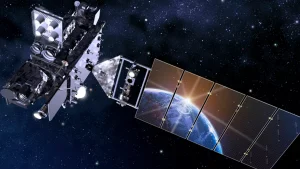
Satellites and Remote Sensing
- NOAA Satellites

Charting and Surveying
- Charts and Surveys
- Tides and Currents
Priority Focus Areas
NOAA frequently identifies areas of critical need within its mission areas where the agency will be focusing its resources in the coming years. These focus areas are also excellent areas for SBIR project proposals.
NOAA Science & Technology Focus Areas
NOAA’s strategies in six key science and technology (S&T) focus areas guide transformative advancements in the quality and timeliness of NOAA’s products and services across our mission areas. Our strategies help us more efficiently and effectively adopt the breakthrough S&T applications to help deliver the world’s best weather forecasts and to grow the American Blue Economy.
- Citizen Science
- Cloud Computing
- Uncrewed Systems
- Artificial Intelligence
- ‘Omics
Contact & Follow Us
SBIR Email: [email protected] or Join Our Mailing List
SBIR Invoice and Payment Questions: [email protected]
Twitter: @NOAAinnovate

- Small Business Innovation Research and Small Business Technology Transfer
Program Areas
The SBIR and STTR programs are U. S. Government programs, intended to help certain small businesses conduct R&D. At DOE, funding takes the form of grants. Projects must have the potential for commercialization and meet specific DOE mission-specific R&D needs.
The SBIR/STTR Programs Office works collaboratively with 13 program offices throughout the DOE. Each DOE program office considers its high priority research needs and program mission, as well as the Department’s goals for the program in developing research topics. The specific research topics selected for the SBIR and STTR programs are developed by DOE technical program managers. DOE offers more than sixty technical topics and 250 subtopics, spanning research areas that support the DOE mission in Energy Production, Energy Use, Fundamental Energy Sciences, Environmental Management, and Defense Nuclear Nonproliferation.

Energy Production & Use
- Fossil Energy
- Fusion Energy Sciences
- Nuclear Energy
- Energy Efficiency & Renewable Energy
Fundamental Energy Sciences
- Advanced Scientific & Computing Research
- Basic Energy Sciences
- Biological and Environmental Research
- High Energy Physics
- Nuclear Physics

Energy Storage & Security
- Electricity
- Cybersecurity, Energy Security & Emergency Response

- Environmental Management
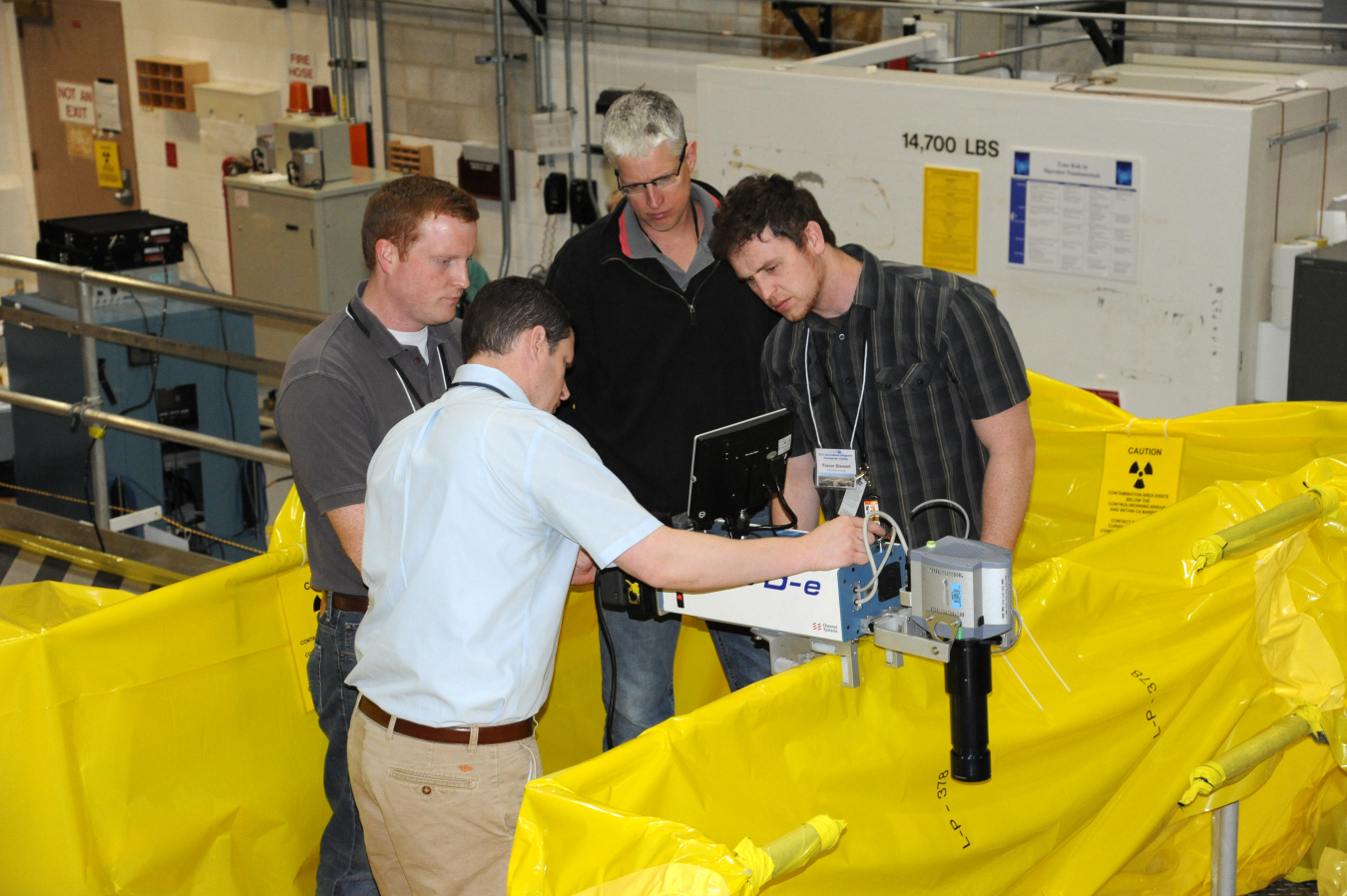
Defense Nuclear Nonproliferation
- Defense Nuclear Nonproliferation R&D
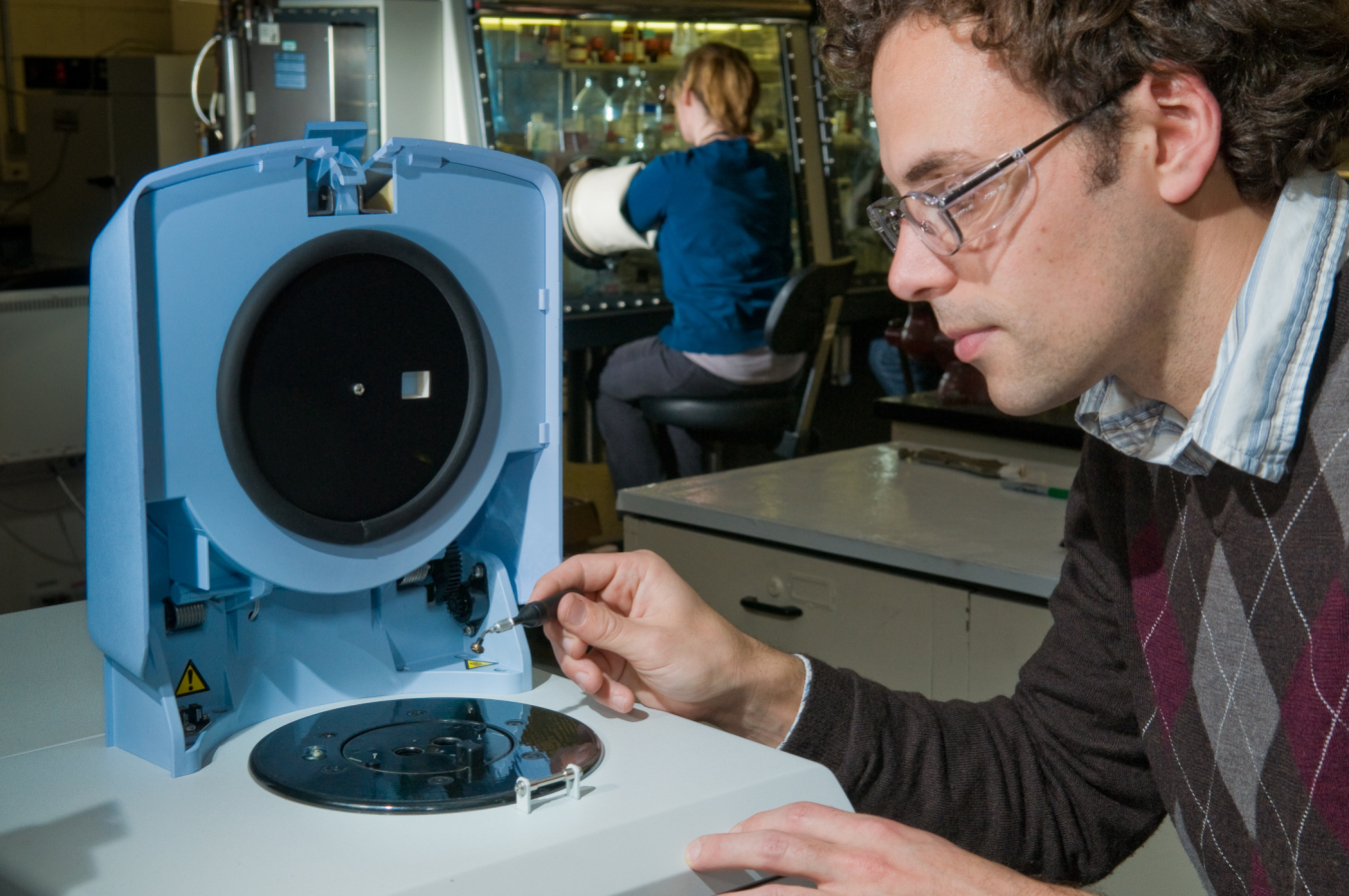
Funding Opportunities
- Phase I & Phase II

Application Resources
- SBIR/STTR Application Prep
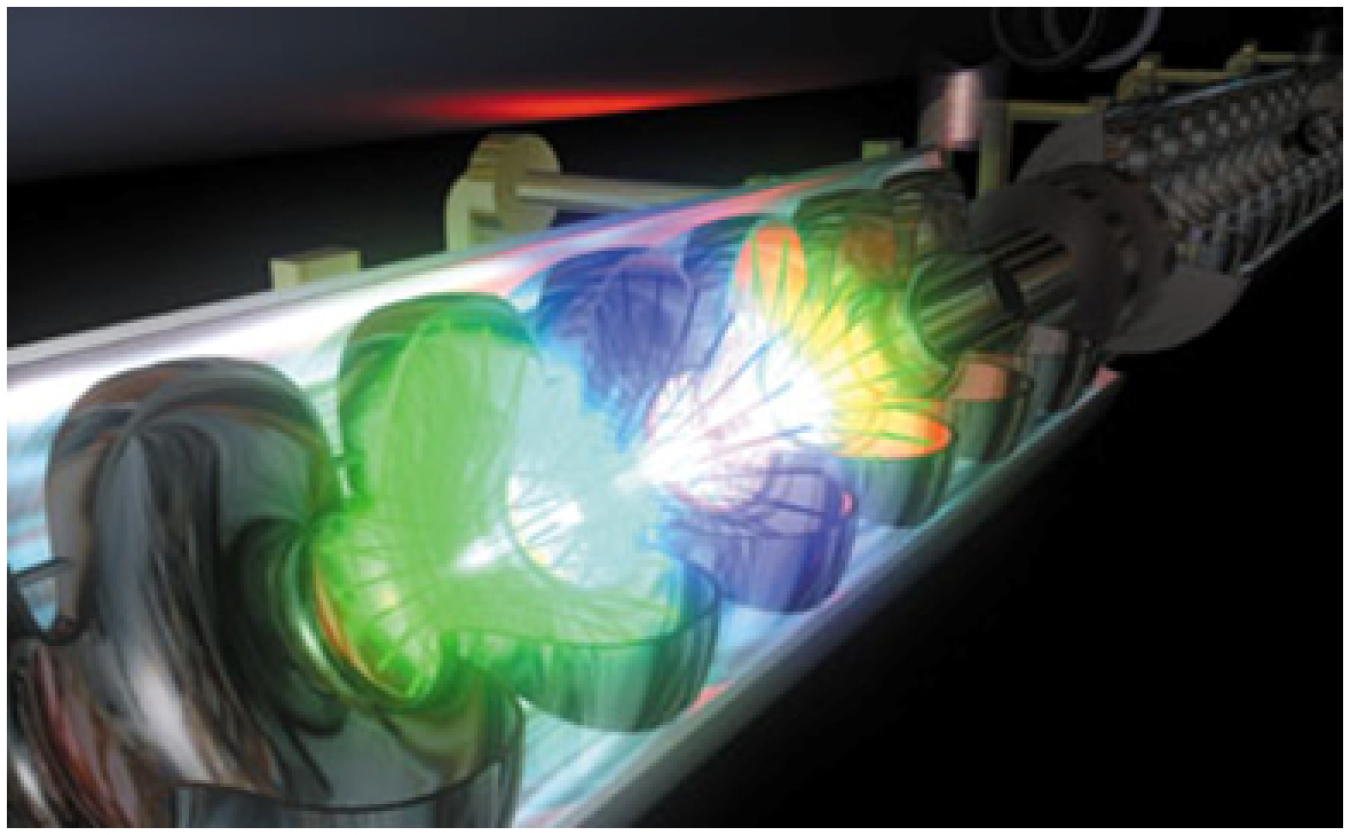
Awardee Resources

Frequently Asked Questions
- All SBIR/STTR FAQ
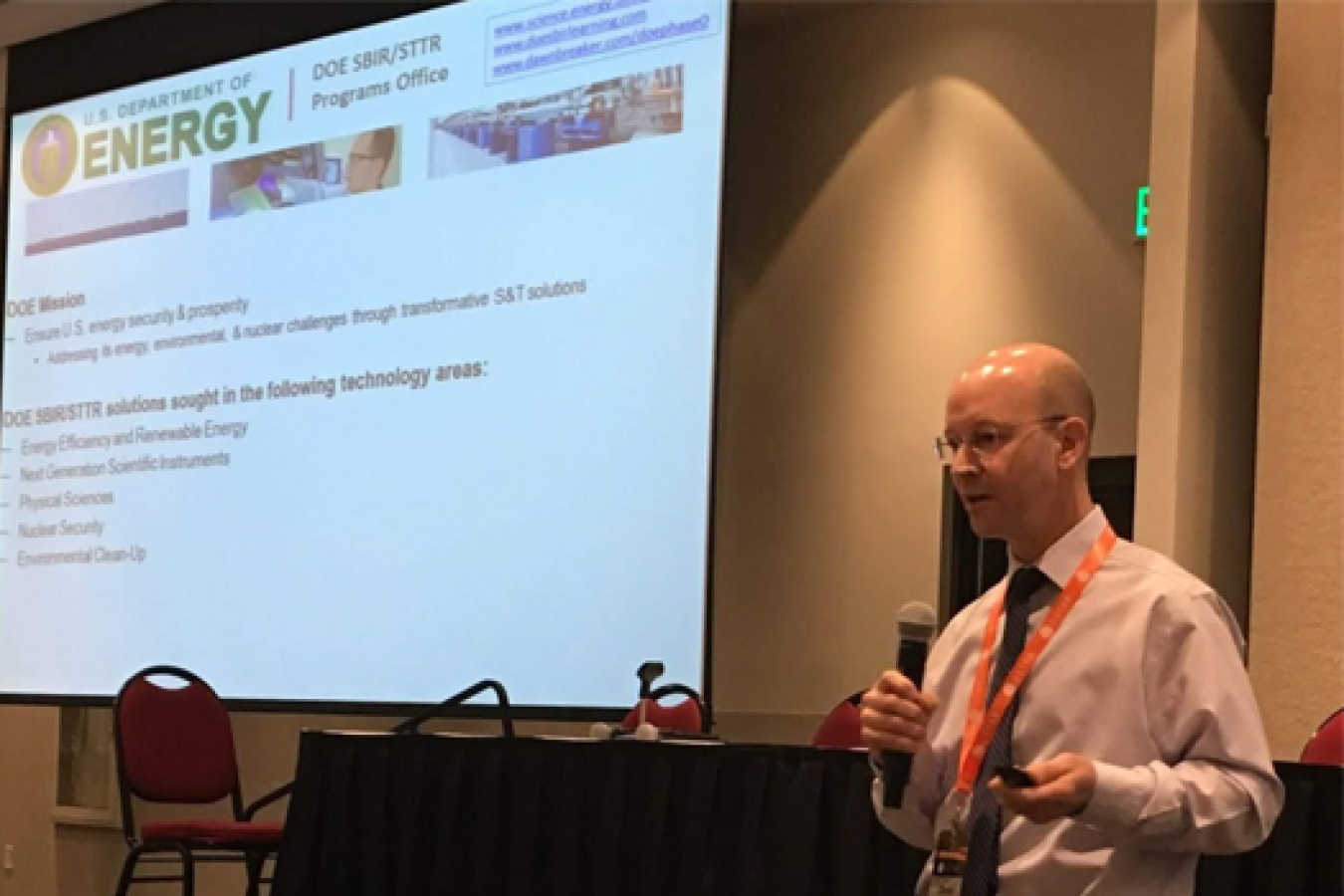
Research Areas & Impact
- Phase III Success Stories
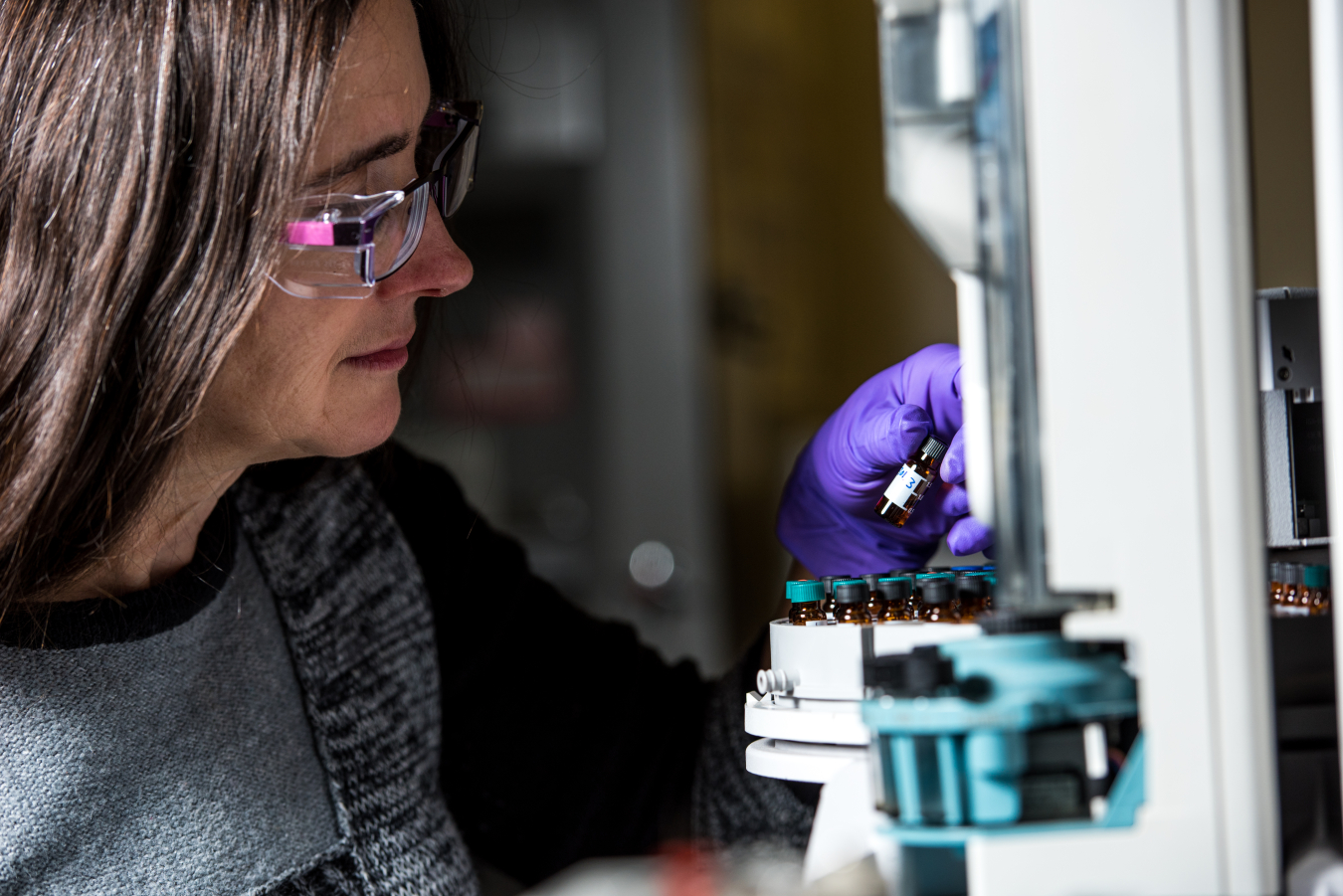
SBIR/STTR Awards
- Sortable Spreadsheet

Reporting Fraud
- DOE Inspector General
Contact Information
SBIR/STTR Programs Office P: (301) 903-5707 F: (301) 903-5488 E: [email protected]
Follow us on Twitter
https://twitter.com/doesbir

An official website of the United States government
Here’s how you know
Official websites use .gov A .gov website belongs to an official government organization in the United States.
Secure .gov websites use HTTPS A lock ( Lock A locked padlock ) or https:// means you’ve safely connected to the .gov website. Share sensitive information only on official, secure websites.
JavaScript appears to be disabled on this computer. Please click here to see any active alerts .
About EPA's SBIR Program
On this page:
Phased Approach to Funding
- Success Stories
- Is SBIR Right for You?
EPA SBIR Solicitation Topics
Subscribe to updates.
Sign up for the EPA SBIR Listserv to stay up to date with EPA SBIR funding opportunities and news!
2024 Program Brochure
EPA-SBIR-Informational-Brochure2024 (pdf) (2.55 MB)
One of 11 federal Small Business Innovation Research (SBIR) programs launched over 40 years ago, EPA’s SBIR program is the small program with a big mission, to protect human health and the environment. As part of "America's Seed Fund," EPA SBIR funds small businesses to develop and commercialize innovative environmental technologies in broad focus areas which include clean and safe water, air quality and climate, land revitalization, homeland security, sustainable materials management/circular economy, safer chemicals, and risk assessment. Proposals should be responsive to the annual topics under these broad areas.
Program Objectives
- Support for innovative green technology
- Focus on commercialization
- Communication of successes
- Protect the planet
For more information on the Federal SBIR programs, visit the Small Business Administration's SBIR website .
SBIR projects are funded in a phased approach. Each year, EPA issues a Phase I solicitation for technology proposals addressing specific topics. Proposals are evaluated on their technical merit, potential for commercialization and impact/relevance in the given topic area.
For Phase I, EPA awards firm-fixed-price contracts of up to $100,000 for 6 months for “proof of concept” of the proposed technology. Small businesses that have received a Phase I can submit a proposal for a Phase II award of $400,000 to further develop and commercialize the technology.
To accelerate commercialization, EPA also offers a "Commercialization Option" of up to $100,000 in Phase II for companies that secure third-party investment.
SBIR Success Stories
Ecovative designs.
Ecovative Designs has developed mushroom-based materials for various uses including packaging, construction materials, and furniture. The company uses bio-fabrication using mycelium grown on natural/waste products as their main source material. Ecovative has achieved multiple successes through gaining clients like Ikea and Crate & Barrel, and launching a spinoff, MyForest Foods to produce gourmet mycelia for whole-food, meat-free ingredients.
AquaRealTime
AquaRealTime , a small business based in Boulder, Colorado, has released a new product, the OxyTracker. The OxyTracker is a cost-effective option for measuring dissolved oxygen (DO) in water, which serves as a crucial indicator of water quality. The device can be used as an early warning system for organic water contamination, such as harmful algal blooms (HABs), allowing users to make important decisions regarding use or access to water. The device can accurately measure DO over a wide range and has even been commercialized with 200 units now operating in 22 states of the US, Canada, and Germany. The OxyTracker is a successor to the focus of AquaRealTime’s SBIR Phase I project , the Algae Tracker
Pure Blue Tech
Pure Blue Tech has developed a technology that uses ultrasound generated via thin and flexible efficient transducers, embedded in membrane filters- which effectively reduces the occurrence of membrane fouling by up to half. This technology can lower the cost of reverse osmosis treatment which is key to many reuse applications. As a result, Pure Blue Tech’s prototype technology has been successfully integrated in industrial-scale reverse osmosis systems and have pilot projects planned across North America to advance this innovative technology. Pure Blue was also able to recently secure an investment of $2 million in funding, to expand their company and accelerate product development.
Read more SBIR Success Stories .

Is EPA SBIR Right for You?
Are you ready to join hundreds of small businesses that have used EPA SBIR awards to develop and commercialize their environmental technologies? If your small business has a technology solution that helps solve one of EPA's priority topic areas, consider submitting your idea to help us protect public health and address our most pressing environmental problems. EPA welcomes proposals from small businesses and start-ups new to the program.
How to Apply for an SBIR Contract
Sign up for the EPA SBIR Listserv to stay up to date with EPA SBIR funding opportunities and news
The most recent EPA SBIR solicitation closed in August 2024. The solicitation topics were:
Clean and Safe Water
- Nature-based Solutions for Water Reuse
- Technologies for the Treatment of PFAS in Wastewater Sewage Sludge and Biosolids
- Treatment for Cyanobacteria and Cyanotoxins in Drinking Water at the Household Scale
Air Quality & Climate
- Technologies and Tools to Monitor and Reduce Air Toxics Exposures
- Air Pollution Control Technologies for Small Sources
Homeland Security
- Scenario-Based Training for Disaster Response
Circular Economy/Sustainable Materials
- Preventing and Recycling Food Waste
- Source Reduction and Reuse
- Lowering Embodied Carbon in the Built Environment
Safer Chemicals
- Rubber Anti-Degradants that are Lower Concern for Human Health and the Environment
- Next Generation Fertilizers
For questions, contact April Richards, SBIR Program Manager ( [email protected] ) or (202) 564-6462
- About SBIR Program
- Resources for Awardees
- SBIR Funding Opportunities
- How to Apply for an SBIR Contract
- SBIR Projects
- About Research Grants

An official website of the United States government
Here’s how you know
Official websites use .gov A .gov website belongs to an official government organization in the United States.
Secure .gov websites use HTTPS A lock ( Lock A locked padlock ) or https:// means you’ve safely connected to the .gov website. Share sensitive information only on official, secure websites.
https://www.nist.gov/news-events/news/2024/09/biden-harris-administration-awards-nearly-5-million-small-businesses-bring
Biden-Harris Administration Awards nearly $5 million to Small Businesses to Bring New CHIPS Technology to the Commercial Market
Department of commerce announces grants across nine states highlight thriving u.s. semiconductor industry.

Media Contact: Hannah Robinson, hannah.robinson [at] chips.gov ( hannah[dot]robinson[at]chips[dot]gov ) .
Today, the Biden-Harris Administration awarded nearly $5 million to 17 small businesses across nine states under the Small Business Innovation Research (SBIR) Program. The SBIR Phase I awards will fund research projects to explore the technical merit or feasibility of an innovative idea or technology for developing a viable product or service for introduction in the commercial microelectronics marketplace. This is the first award for the CHIPS Research and Development Office. The Biden-Harris Administration is dedicated to getting small businesses the resources they need to thrive and promoting competition to level the playing field.
“As we grow the U.S. semiconductor industry, the Biden-Harris Administration is committed to building opportunities for small businesses to prosper. With today’s awards, these 17 businesses will support CHIPS for America’s efforts to grow the U.S. semiconductor ecosystem and support our national and economic security” said U.S. Secretary of Commerce Gina Raimondo .
NIST measurement science, or metrology, is at the heart of all the advances we anticipate from American chipmakers in coming years, like smaller, faster, chips that take less energy to make, operate and cool, with more functions at less expense. The award-winning projects were competitively selected from proposals submitted in response to a Notice of Funding Opportunity (NOFO) on multiple topics on research projects for critically needed measurement services, tools, and instrumentation; innovative manufacturing metrologies; novel assurance and provenance technologies and advanced metrology research and development (R&D) testbeds to help secure U.S. leadership in the global semiconductor industry.
These are all Phase I SBIR awards, which are meant to establish the merit, feasibility and commercial potential of the proposed research and development projects. All 17 small businesses will be under consideration for a SBIR Phase II award in Spring 2025. Each Phase II award can be funded up to $1,910,000.
“NIST and CHIPS for America are proud to support these small businesses as they take innovations, scale them for the commercial marketplace, and boost the U.S. economy. We are happy to support the entrepreneurs with great ideas as they seek to build the next great American company,” said Under Secretary of Commerce for Standards and Technology and National Institute of Standards and Technology (NIST) Director Laurie E. Locascio .
CHIPS Metrology SBIR Awardees
Direct Electron LP (Rancho Bernardo, California) Develop a novel high-speed camera for high-resolution electron backscatter diffraction and transmission Kikuchi diffraction which will significantly expand the materials properties that can be probed with this technique. This project will benefit U.S. industry using materials characterization for current and next-generation microelectronics devices.
HighRI Optics, Inc (Oakland, California) Develop cutting-edge technology for calibration of the instrument transfer function of extreme ultraviolet (EUV) lithographic tools. This project will advance EUV lithography technology for the U.S. semiconductor industry.
Photon Spot, Inc. (Monrovia, California) Develop an ultra-compact, ultra-low vibration cryogenic system to support time-resolved imaging applications. This project will benefit integrated circuit manufacturers and researchers conducting experiments on quantum technologies.
Photothermal Spectroscopy Corporation (Santa Barbara, California) Develop a new instrument for high-speed thermal properties analysis and simultaneous chemical characterization with sub-micron spatial resolution. This project will improve thermal management and thermal property characterization for the U.S. semiconductor industry.
PrimeNano Inc (Santa Clara, California) Develop a measurement technology for in-line metrology, which has applications in materials purity, electrical properties, three-dimensional devices, and next generation manufacturing. This project will benefit the U.S. metrology and advanced packaging industries.
Recon RF, Inc. (San Diego, California) Develop next-generation large-signal and high-power transistor modeling techniques to create highly accurate models for Radio Frequency (RF)-Microwave circuit design simulators. This project will benefit researchers and U.S. manufacturers of advanced radar, communications, and satellite technologies.
Sigray, Inc (Concord, California) Develop a novel linear accumulation x-ray source to achieve an order of magnitude increase in performance over leading x-ray sources for critical dimension scattering. This project benefits researchers and manufacturers of semiconductor transistors.
Vapor Cell Technologies (Boulder, Colorado) Develop advanced dimensional metrology tools for semiconductor fabrication equipment to minimize the gap in the physical-digital divide and amplifying the accuracy of digital twins. This project will benefit the U.S. microelectronics supply chain.
Tech-X Corporation (Boulder, Colorado) Develop a simulation tool for photonic integrated circuits that accounts for manufacturing variations and imperfections. This project will benefit the designers of photonic integrated circuits, who will have faster development times as well as U.S. semiconductor manufacturers and fabrication facilities.
Octave Photonics LLC (Louisville, Colorado) Develop a new measurement tool to analyze airborne contaminants and toxic gases inside and outside the fab that lead to semiconductor processing defects and safety infringements. This project will benefits U.S semiconductor fabrication facilities.
Virtual EM, Inc. (Ann Arbor, Michigan) Develop a Radio Frequency (RF) channel sounder system to accurately characterize the effects of the wireless environment. This project will benefit microelectronics companies and research institutions focused on communication technologies.
The Provenance Chain Network (Portland, Oregon) Develop a reference implementation of the Commercial Trust™ Protocol (CTP) to manage verifiable credentials (VCs), metrology, and intellectual property, enhancing hardware security, and provenance tracking of microelectronic components across supply chains. This project will benefit the U.S. microelectronics supply chain industry.
Tiptek, LLC (West Chester, Pennsylvania) Develop new high-speed nanoprobes to enhance the ability for semiconductor failure analysis to locate and analyze to detect "soft' electrical faults that occur on the most advanced semiconductors and are otherwise difficult to detect. This project will benefit researchers and semiconductor failure analysis engineers in the U.S. semiconductor industry.
Exigent Solutions (Frisco, Texas) Develop AI-powered software to automate chip design optimization for manufacturability through accelerated lithography simulation. This project will benefit U.S. researchers and industry involve in semiconductor design and manufacturing.
Laser Thermal Analysis, Inc (Charlottesville, Virginia) Develop hybrid atomic force microscopy instrument that will automatically generate maps of the thermal resistance, thermal boundary interface resistance, and temperature profiles of microprocessors and wide bandgap semiconductor materials and devices. This project will benefit devices with thermal management challenges and materials development needs on length scales smaller than 100 nanometers.
Hummingbird Precision Machine Co. dba Hummingbird Scientific (Olympia, Washington) Develop a transmission electron microscopy in-situ specimen holder that enables real-time imaging of nano-scale electronic devices. The project will benefit manufacturers and researchers of next-generation high-voltage power converters used in a wide variety of industries.
Steam Instruments (Madison, Wisconsin) Develop a rapid and accurate high-resolution ion microscopy technology for materials characterization particularly focused on challenges for the semiconductor industry. This project will benefit the U.S. semiconductor industry and researchers.
Learn more about the CHIPS Metrology Program and the seven grand challenges .
About CHIPS for America CHIPS for America has allocated over $32 billion in proposed funding across 16 states and proposed to invest billions more in research and innovation, which will create over 115,000 jobs. Since the beginning of the Biden-Harris Administration, semiconductor and electronics companies have announced over $400 billion in private investments, catalyzed in large part by public investment. CHIPS for America is part of President Biden and Vice President Harris’s economic plan to invest in America, stimulate private sector investment, create good-paying jobs, make more in the United States, and revitalize communities left behind. CHIPS for America includes the CHIPS Program Office, responsible for manufacturing incentives, and the CHIPS Research and Development Office, responsible for R&D programs, that both sit within the National Institute of Standards and Technology (NIST) at the Department of Commerce. Visit https://www.chips.gov to learn more.
The CHIPS Metrology Program is building partnerships between researchers and industry to address the microelectronics industry’s metrology grand challenges. CHIPS for America has funded over $190 million across over 40 projects that are helping to develop new instruments, methods, data analysis, and models and simulations.

An official website of the United States government
Here’s how you know
Official websites use .gov A .gov website belongs to an official government organization in the United States.
Secure .gov websites use HTTPS A lock ( ) or https:// means you’ve safely connected to the .gov website. Share sensitive information only on official, secure websites.

- Explore sell to government
- Ways you can sell to government
- How to access contract opportunities
- Conduct market research
- Register your business
- Certify as a small business
- Become a schedule holder
- Market your business
- Research active solicitations
- Respond to a solicitation
- What to expect during the award process
- Comply with contractual requirements
- Handle contract modifications
- Monitor past performance evaluations
- Explore real estate
- 3D-4D building information modeling
- Art in architecture | Fine arts
- Computer-aided design standards
- Commissioning
- Design excellence
- Engineering
- Project management information system
- Spatial data management
- Facilities operations
- Smart buildings
- Tenant services
- Utility services
- Water quality management
- Explore historic buildings
- Heritage tourism
- Historic preservation policy, tools and resources
- Historic building stewardship
- Videos, pictures, posters and more
- NEPA implementation
- Courthouse program
- Land ports of entry
- Prospectus library
- Regional buildings
- Renting property
- Visiting public buildings
- Real property disposal
- Reimbursable services (RWA)
- Rental policy and procedures
- Site selection and relocation
- For businesses seeking opportunities
- For federal customers
- For workers in federal buildings
- Explore policy and regulations
- Acquisition management policy
- Aviation management policy
- Information technology policy
- Real property management policy
- Relocation management policy
- Travel management policy
- Vehicle management policy
- Federal acquisition regulations
- Federal management regulations
- Federal travel regulations
- GSA acquisition manual
- Managing the federal rulemaking process
- Explore small business
- Explore business models
- Research the federal market
- Forecast of contracting opportunities
- Events and contacts
- Explore travel
- Per diem rates
- Transportation (airfare rates, POV rates, etc.)
- State tax exemption
- Travel charge card
- Conferences and meetings
- E-gov travel service (ETS)
- Travel category schedule
- Federal travel regulation
- Travel policy
- Explore technology
- Cloud computing services
- Cybersecurity products and services
- Data center services
- Hardware products and services
- Professional IT services
- Software products and services
- Telecommunications and network services
- Work with small businesses
- Governmentwide acquisition contracts
- MAS information technology
- Software purchase agreements
- Cybersecurity
- Digital strategy
- Emerging citizen technology
- Federal identity, credentials, and access management
- Mobile government
- Technology modernization fund
- Explore about us
- Annual reports
- Mission and strategic goals
- Role in presidential transitions
- Get an internship
- Launch your career
- Elevate your professional career
- Discover special hiring paths
- Climate Action
- Events and training
- Agency blog
- Congressional testimony
- GSA does that podcast
- News releases
- Leadership directory
- Staff directory
- Office of the Administrator
- Federal Acquisition Service
- Public Buildings Service
- Staff offices
- Board of Contract Appeals
- Office of Inspector General
- Region 1 | New England
- Region 2 | Northeast and Caribbean
- Region 3 | Mid-Atlantic
- Region 4 | Southeast Sunbelt
- Region 5 | Great Lakes
- Region 6 | Heartland
- Region 7 | Greater Southwest
- Region 8 | Rocky Mountain
- Region 9 | Pacific Rim
- Region 10 | Northwest/Arctic
- Region 11 | National Capital Region
- Per Diem Lookup
This is archived information. It may contain outdated contact names, telephone numbers, Web links, or other information. For up-to-date information visit GSA.gov pages by topic or contact our Office of Public Affairs at [email protected] . For a list of public affairs officers by beat, visit the GSA Newsroom .
GSA Announces Launch of Small Business Innovation Research Program Phase III Pilot
Washington, D.C. -- The U.S. General Services Administration (GSA) today announced it is launching a pilot program to award and manage Small Business Innovation Research (SBIR) Phase III contracts. Awards will be made and managed by GSA’s Office of Assisted Acquisition Services (AAS) during the pilot, which will run through September 2019.
The SBIR program is a highly competitive awards-based program coordinated by the U.S. Small Business Administration (SBA) that encourages domestic small businesses to explore their research/research and development (R/R&D) potential and provides an incentive for them to profit from its commercialization. The program is structured in three phases; Phases I and II focus on R/R&D, while Phase III’s objective is to pursue commercialization objectives resulting from Phase I/II R/R&D activities.
“GSA’s SBIR pilot is an exciting opportunity to bring innovative solutions into the federal marketplace, support American small businesses, facilitate job creation and strengthen our industrial base,” said GSA Administrator Emily Murphy. “Awarding SBIR Phase III contracts allows GSA to bring these cutting-edge solutions directly to our partner agencies. This is a great example of how GSA is improving the way federal agencies access and use technology to address complex problems.”
“Helping small businesses commercialize new solutions developed with assistance from the SBIR program increases the return on investment from federal research and development funding and supports private sector job growth,” said SBA Administrator Linda McMahon. “The SBA looks forward to working with GSA to encourage the entrepreneurship and innovation associated with the SBIR program and continuing SBA’s efforts to impact the growth of our nation’s small businesses.”
The pilot will help GSA determine how best to expand this research and commercialization service offering. The pilot will be led by AAS’s Great Lakes Region (Region 5) and AAS’s Federal Systems Integration and Management (FEDSIM) teams. GSA’s Dr. Rodney Couick, who leads the AAS Region 5 team, was recently awarded the Small Business Technology Council’s “2018 Champion of Small Business Technology Commercialization” award for his efforts to support SBIR contracting needs and development of the SBIR pilot program.
“For an organization to thrive, it has to promote a culture of responsible innovation” said GSA’s Senior Procurement Executive Jeffrey Koses. “GSA achieves this by focusing the pilot on SBIR’s commercialization phase. This enables FEDSIM and Region 5, in collaboration with my office, to identify and resolve potential issues and share best practices that will inform our next steps.”
The mission of the U.S. General Services Administration is to deliver value and savings in real estate, acquisition, technology, and other mission-support services across government. One of its four strategic objectives is to improve the way federal agencies buy, build and use technology.
The SBIR program was established in statute by the Small Business Innovation Development Act of 1982 (P.L. 97-219) and has subsequently been reauthorized by Congress on several occasions over the past 36 years.
The SBIR program is structured in three phases. The objective of Phase I is to establish the technical merit, feasibility, and commercial potential of the proposed research/research & development (R/R&D) efforts and to determine the quality of performance of the small business awardee organization prior to providing further federal support in Phase II. The objective of Phase II is to continue the R/R&D efforts initiated in Phase I. The objective of Phase III, where appropriate, is for the small business to pursue commercialization objectives resulting from the Phase I/II R/R&D activities.
PER DIEM LOOK-UP
1 choose a location.
Error, The Per Diem API is not responding. Please try again later.
No results could be found for the location you've entered.
Rates for Alaska, Hawaii, U.S. Territories and Possessions are set by the Department of Defense .
Rates for foreign countries are set by the State Department .
2 Choose a date
Rates are available between 10/1/2022 and 09/30/2025.
The End Date of your trip can not occur before the Start Date.
Traveler reimbursement is based on the location of the work activities and not the accommodations, unless lodging is not available at the work activity, then the agency may authorize the rate where lodging is obtained.
Unless otherwise specified, the per diem locality is defined as "all locations within, or entirely surrounded by, the corporate limits of the key city, including independent entities located within those boundaries."
Per diem localities with county definitions shall include "all locations within, or entirely surrounded by, the corporate limits of the key city as well as the boundaries of the listed counties, including independent entities located within the boundaries of the key city and the listed counties (unless otherwise listed separately)."
When a military installation or Government - related facility(whether or not specifically named) is located partially within more than one city or county boundary, the applicable per diem rate for the entire installation or facility is the higher of the rates which apply to the cities and / or counties, even though part(s) of such activities may be located outside the defined per diem locality.
An official website of the United States government
Here's how you know
Official websites use .gov A .gov website belongs to an official government organization in the United States.
Secure .gov websites use HTTPS. A lock ( Lock Locked padlock ) or https:// means you've safely connected to the .gov website. Share sensitive information only on official, secure websites.
Active funding opportunity
Nsf 24-579: nsf small business innovation research / small business technology transfer phase i programs, program solicitation, document information, document history.
- Posted: May 30, 2024
- Replaces: NSF 23-515
Program Solicitation NSF 24-579
|
Full Proposal Deadline(s) (due by 5 p.m. submitting organization’s local time):
September 18, 2024
November 06, 2024
March 05, 2025
July 02, 2025
November 05, 2025
Important Information And Revision Notes
The NSF SBIR/STTR programs (also known as America’s Seed Fund powered by NSF) provide non-dilutive grants for the development of a broad range of technologies based on discoveries in science and engineering with the potential for societal and economic impacts .
NSF proposals are confidential and will only be shared with a select number of reviewers and NSF staff (as appropriate). All reviewers have agreed to maintain the confidentiality of the proposal content. Proposals to NSF do not constitute a public disclosure. If selected for a Phase I award, the company will be prompted to write a publicly available abstract that summarizes the intellectual merit and broader impact of the project.
The proposer must receive an official invitation via the Project Pitch process to submit a full proposal. Small businesses can submit a Project Pitch at any time. Small businesses that receive an official invite must submit their full proposal within the next two deadlines of the email date of their invite; for example, if a Project Pitch invite is received on May 30, 2024, the proposer may submit their full proposal for either of the next two deadlines (September 18, 2024 or November 6, 2024). Visit the program website ( https://seedfund.nsf.gov/apply/project-pitch/ ) for more information.
The proposal submission system, Research.gov, will stop accepting proposals at 5:00 pm “submitting organization’s local time.” This is a firm deadline (no grace period). If your submission is late, you will not be able to submit again until the next deadline (and only if your Project Pitch invite remains valid). Proposers are strongly urged to submit well in advance of the deadline.
The NSF SBIR/STTR programs do not support clinical trials or proposals from companies whose commercialization pathway involves the production, distribution, or sale by the company of chemical components, natural or synthetic variations thereof, or other derivatives related to Schedule I controlled substances.
All proposals must be submitted through Research.gov .
SBIR and STTR proposals are nearly identical but differ in the amount of work required to be performed by the small business and a not-for-profit institution or a Federally funded research and development center (FFRDC) (as noted in the budget). For more information about the unique requirements for STTR awards, please refer to the Eligibility and Proposal Preparation sections of this solicitation.
NSF SBIR Phase I proposals submitted to this solicitation may, at NSF's discretion, be converted for award as an STTR Phase I.
For the purpose of this solicitation, the following definitions apply:
- Funding Agreement: As used in this solicitation, the funding agreement is a Grant – a legal instrument of financial assistance between NSF and a recipient, consistent with 31 USC 6302-6305 and as noted in the NSF Proposal & Award Policies & Procedures Guide (PAPPG) Introduction, Section D ("Definitions & NSF-Recipient Relationships").
- Small Business Concerns (SBCs): SBCs are independently owned and operated businesses that are not dominant in their field of operation. For this solicitation, firms qualifying as a small business concern are eligible to participate in the SBIR/STTR programs (see Section IV. "Eligibility Information" of this solicitation for more details). Please note that the size limit of 500 employees includes affiliates. The firm must be in compliance with the SBA SBIR/STTR Policy Directive and the Code of Federal Regulations .
- SBIR/STTR Data: As defined by the SBA SBIR/STTR Policy Directive , SBIR/STTR Data is all Data developed or generated in the performance of an SBIR or STTR award, including Technical Data and Computer Software developed or generated in the performance of an SBIR or STTR award. The term does not include information incidental to contract or grant administration, such as financial, administrative, cost or pricing or management information.
- SBIR/STTR Data Rights: The Federal Government may, use, modify, reproduce, perform, display, release, or disclose SBIR/STTR Data that are Technical Data within the Government; however, the Government shall not use, release, or disclose the data for procurement, manufacturing, or commercial purposes; or release or disclose the SBIR/STTR Data outside the Government except as permitted by paragraph 10(B) of the SBIR/STTR Policy Directive 's Data Rights Clause or by written permission of the recipient.
- the application of creative, original, and potentially transformative concepts to systematically study, create, adapt, or manipulate the structure and behavior of the natural or man-made worlds;
- the use of the scientific method to propose well-reasoned, well-organized activities based on sound theory, computation, measurement, observation, experiment, or modeling;
- the demonstration of a well-qualified individual, team, or organization ready to deploy novel methods of creating, acquiring, processing, manipulating, storing, or disseminating data or metadata; and/or
- the novel integration of new theories, analysis, data, or methods regarding cognition, heuristics, and related phenomena, which can be supported by scientific rationale.
- Non-Dilutive Funding: financing that does not involve equity, debt, or other elements of the business ownership structure.
- Technical Risk: Technical risk assumes that the possibility of technical failure exists for an envisioned product, service, or solution to be successfully developed. This risk is present even to those suitably skilled in the art of the component, subsystem, method, technique, tool, or algorithm in question.
- Technical Innovation: Technical innovation indicates that the new product or service is differentiated from current products or services; that is, the new technology holds the potential to result in a product or service with a substantial and durable advantage over competing solutions on the market. It also generally provides a barrier to entry for competitors. This means that if the new product, service, or solution is successfully realized and brought to the market, it would be difficult for a well-qualified, competing firm to reverse-engineer or otherwise neutralize the competitive advantage generated by leveraging fundamental science or engineering research techniques.
Significant Revisions Made Since the Last Solicitation:
The maximum total Phase I award amount has been increased from $275,000 to $305,000. This amount is inclusive of all direct and indirect costs as well as the small business fee.
In an effort to increase the award amount, to increase the flexibility of the PI to make decisions based on the needs of their particular company, and to decrease the administrative burden associated with preparing and processing significant numbers of supplement requests, SBIR/STTR Phase I recipients should budget for Technical and Business Assistance (TABA) and National Innovation-Corps training (I-Corps TM ) (see below) within their Phase I budget. Other supplements to SBIR/STTR Phase I awards will not be allowed .
TABA provides an opportunity to assist small businesses in commercialization of their technologies. Up to $6,500 for TABA funding may be budgeted by the proposing small business for their well justified commercialization activities. TABA funding enables the recipient business to secure the services of one or more third-party providers to assist in one or more of the following commercialization activities: making better technical decisions on SBIR/STTR projects; solving technical problems that arise during SBIR/STTR projects; minimizing technical risks associated with SBIR/STTR projects; and/or commercializing the SBIR/STTR product or process, including securing intellectual property protections.
I-Corps training is highly recommended; The proposal budget should include $25,000 for this training. Beat the Odds Boot Camp (a condensed version of I-Corps) will no longer be offered.
The award duration has been extended; SBIR/STTR Phase I awards may be 6-18 months.
Publication, documentation, and dissemination costs are not allowed.
An Allocation of Intellectual Property Rights Agreement (IP Rights Agreement) is required for STTR proposals and strongly recommended for SBIR proposals when there is a subaward to another institution. A fully signed agreement is not required for STTR proposals at the initial proposal submission but will be required before a recommendation for an award can be made.
In addition to the two NSF Merit Review Criteria (Intellectual Merit and Broader Impacts), additional solicitation specific review requirements related to Intellectual Merits, Broader Impacts, Company/Team, and Commercialization Potential have been clarified, see Section VI.A. An Elevator Pitch is no longer required in the Project Description.
Four documents: Biographical Sketch(es), Current and Pending (Other) Support forms, Collaborators and Other Affiliations (COA), and Synergistic Activities must be submitted for the PI, Co-PI (if STTR), and each Senior/Key Personnel specified in the proposal. Biographical Sketches and Current and Pending Support forms must be submitted using SciENcv: Science Experts Network Curriculum Vitae . Collaborators & Other Affiliations (COA) Information is submitted using the instructions and spreadsheet template . Additional information is given in the solicitation. Synergistic Activities. Each individual identified as a Senior/Key person must provide a document of up to one-page that includes a list of up to five distinct examples of synergistic activities that demonstrate the broader impact of the individual’s professional and scholarly activities that focus on the integration and transfer of knowledge as well as its creation.
In accordance with Section 10632 of the CHIPS and Science Act of 2022 (42 U.S.C. § 19232), the Authorized Organizational Representative (AOR) must certify that all individuals identified as Senior/Key Personnel have been made aware of and have complied with their responsibility under that section to certify that the individual is not a party to a Malign Foreign Talent Recruitment Program.
In accordance with Section 223(a)(1) of the William M. (Mac) Thornberry National Defense Authorization Act for Fiscal Year 2021 (42 U.S.C. § 6605(a)(1)), each individual identified as Senior/Key Personnel is required to certify in SciENcv that the information provided in the Biographical Sketch and Current and Pending (Other) Support documents is accurate, current, and complete. Senior/Key Personnel are required to update their Current and Pending (Other) Support disclosures prior to award, and at any subsequent time the agency determines appropriate during the term of the award. See additional information on NSF Disclosure Requirements in the PAPPG, Chapter II.B. Each Senior/Key Person must also certify prior to proposal submission that they are not a party to a Malign Foreign Talent Recruitment Program and annually thereafter for the duration of the award.
Letters of Support from potential product/service users or customers are NOT ALLOWED in SBIR/STTR Phase I proposals. Letters of Commitment from subawardees that confirm the role of the subaward organization in the project and explicitly state the subaward amount should be included in the Supplementary Documents.
Additional information on the due diligence process , used as part of the review and selection process, has been clarified in Section VI. The due diligence process may include requests for clarification of the company structure, key personnel, conflicts of interest, foreign influence, cybersecurity practices, or other issues as determined by NSF. Participation in due diligence does not ensure an award recommendation.
This solicitation contains many instructions that deviate from the standard NSF PAPPG proposal preparation instructions. In the event of a conflict between the instructions in this solicitation and the PAPPG, use this solicitation’s instructions as a guide.
Any proposal submitted in response to this solicitation should be submitted in accordance with the NSF Proposal & Award Policies & Procedures Guide (PAPPG) that is in effect for the relevant due date to which the proposal is being submitted. The NSF PAPPG is regularly revised and it is the responsibility of the proposer to ensure that the proposal meets the requirements specified in this solicitation and the applicable version of the PAPPG. Submitting a proposal prior to a specified deadline does not negate this requirement.
Summary Of Program Requirements
General information.
Program Title:
NSF Small Business Innovation Research / Small Business Technology Transfer Phase I Programs (SBIR/STTR Phase I)
The NSF SBIR/STTR programs provide non-dilutive funds for use-inspired research and development (R&D) of unproven, leading-edge, technology innovations that address societal challenges. By investing federal research and development funds into startups and small businesses, NSF helps build a strong national economy and stimulates the creation of novel products, services, and solutions in the private sector; strengthens the role of small business in meeting federal research and development needs; increases the commercial application of federally-supported research results; and develops and increases the U.S. workforce, especially by fostering and encouraging participation by socially and economically-disadvantaged and women-owned small businesses. NSF seeks unproven, leading-edge technology innovations that demonstrate the following characteristics: The innovations are underpinned and enabled by a new scientific discovery or meaningful engineering innovation. The innovations still require intensive technical research and development to be fully embedded in a reliable product or service. The innovations have not yet been reduced to practice by anyone and it is not guaranteed, at present, that doing so is technically possible. The innovations provide a strong competitive advantage that are not easily replicable by competitors (even technically proficient ones). Once reduced to practice, the innovations are expected to result in a product or service that would either be disruptive to existing markets or create new markets/new market segments. The NSF SBIR/STTR programs fund broadly across scientific and engineering disciplines and do not solicit specific technologies or procure goods and services from startups and small businesses. The funding provided is non-dilutive. Any invention conceived or reduced to practice with the assistance of SBIR/STTR funding is subject to the Bayh-Dole Act. For more information, refer to the SBIR/STTR Frequently Asked Questions, #75 . NSF encourages input and participation from the full spectrum of diverse talent that society has to offer which includes underrepresented and underserved communities. This program is governed by 15 U.S.C. 638 and the National Science Foundation Act of 1950, as amended ( 42 U.S.C. 1861 et seq. ). Introduction to Program: The SBIR and STTR programs, initiated at NSF, were established in 1982 as part of the Small Business Innovation Development Act. The NSF SBIR/STTR programs focus on stimulating technical innovation from diverse entrepreneurs and startups by translating new scientific and engineering discoveries emerging from the private sector, federal labs, and academia into products and services that can be scaled and commercialized into sustainable businesses with significant societal benefits. The NSF SBIR/STTR programs are now part of the Directorate for Technology, Innovation and Partnerships (TIP) , which was recently launched to accelerate innovation and enhance economic competitiveness by catalyzing partnerships and investments that strengthen the links between fundamental research and technology development, deployment, and use.
Cognizant Program Officer(s):
Please note that the following information is current at the time of publishing. See program website for any updates to the points of contact.
NSF SBIR/STTR Inbox, telephone: (703) 292-5111, email: [email protected]
- 47.041 --- Engineering
- 47.049 --- Mathematical and Physical Sciences
- 47.050 --- Geosciences
- 47.070 --- Computer and Information Science and Engineering
- 47.074 --- Biological Sciences
- 47.075 --- Social Behavioral and Economic Sciences
- 47.076 --- STEM Education
- 47.079 --- Office of International Science and Engineering
- 47.083 --- Office of Integrative Activities (OIA)
- 47.084 --- NSF Technology, Innovation and Partnerships
Award Information
Anticipated Type of Award: Standard Grant
- approximately 230-235 awards for SBIR Phase I per year, pending the availability of funds
- approximately 45-50 awards for STTR Phase I per year, pending the availability of funds
- Approximately $70,000,000-$72,000,000 for SBIR Phase I
- Approximately $13,000,000-$15,000,000 for STTR Phase I
- Estimated program budget, number of awards and average award size/duration are subject to the availability of funds.
Eligibility Information
Who May Submit Proposals:
Proposals may only be submitted by the following: Proposers must obtain an official invitation to submit a proposal. To receive the invitation, potential proposers must submit a Project Pitch and receive an official response (via email) from the cognizant Program Officer. Project Pitch invitations are valid for two deadlines after the date of the initial official invitation from NSF; for example, if an official invitation is received on May 30, 2024, the proposer may submit for either the September 18, 2024, or November 6 deadline. In this example, submissions after November 6, 2024 will require a new Project Pitch invitation. Firms qualifying as a small business concern are eligible to participate in the NSF SBIR/STTR programs (see Eligibility Guide for more information). Please note that the size limit of 500 employees includes affiliates. The firm must be in compliance with the SBIR/STTR Policy Directive and the Code of Federal Regulations ( 13 CFR Part 121 ). For STTR proposals, the proposing small business must also include a partner research institution in the project, see additional details below. In compliance with the CHIPS and Science Act of 2022 , Section 10636 (Person or entity of concern prohibition) ( 42 U.S.C. 19235 ): No person published on the list under section 1237(b) of the Strom Thurmond National Defense Authorization Act for Fiscal Year 1999 ( Public Law 105-261 ; 50 U.S.C. 1701 note ) or entity identified under section 1260H of the William M. (Mac) Thornberry National Defense Authorization Act for Fiscal Year 2021 ( 10 U.S.C. 113 note ; Public Law 116-283 ) may receive or participate in any grant, award, program, support, or other activity under the Directorate for Technology, Innovation and Partnerships. Individuals who are a current party to a Malign Foreign Talent Recruitment Program are not eligible to serve as a Senior/Key Person on an NSF proposal or on any NSF award made after May 20, 2024. See current PAPPG for additional information on required certifications associated with Malign Foreign Talent Organization. The Authorized Organizational Representative (AOR) must certify that all individuals identified as Senior/Key Personnel have been made aware of and have complied with their responsibility under that section to certify that the individual is not a party to a Malign Foreign Talent Recruitment Program. The startup’s or small business’ research and development (R&D) must be performed within the United States. Startups and small businesses funded by NSF must be majority U.S.-owned companies. NSF does not fund proposals from companies that are majority-owned by one or more venture capital operating companies (VCOCs), hedge funds, or private equity firms. Proposals from joint ventures and partnerships are permitted, provided the proposing entity qualifies as a small business concern (see Eligibility Guide for more information). “Collaborative Proposal from Multiple Organizations” (a special proposal type in Research.gov) are not allowed. Startups and small businesses that have a social mission in their charter are encouraged to apply. Socially and economically disadvantaged small businesses and women-owned small businesses are also encouraged to apply.
Who May Serve as PI:
The primary employment of the Principal Investigator (PI) must be with the small business at the time of award and for the duration of the award, unless a new PI is named. Primary employment is defined as at least 51 percent employed by the small business. NSF normally considers a full-time work week to be 40 hours and considers employment elsewhere of greater than 19.6 hours per week to be in conflict with this requirement. The PI must have a legal right to work for the proposing company in the United States, as evidenced by citizenship, permanent residency, or an appropriate visa. The PI does not need to be associated with an academic institution. There are no PI degree requirements (i.e., the PI is not required to hold a Ph.D. or any other degree). A PI must devote a minimum of one calendar month of effort per six months of performance to an NSF SBIR/STTR Phase I project.
Limit on Number of Proposals per Organization: 1
An organization may submit only one NSF SBIR/STTR Phase I Project Pitch and/or proposal per submission deadline. The organization must wait for a determination from NSF (e.g., invite/not invite for a Project Pitch or award, decline, or return without review for a proposal) before submitting a new Project Pitch or proposal. This eligibility constraint is strictly enforced. If an organization exceeds this limit, the first Project Pitch/proposal that is received will be reviewed and any additional Project Pitches/proposals will be Returned Without Review. Previously declined proposals require a new Project Pitch be submitted and invited. If invited, these proposals must represent a significant revision to the previously submitted SBIR/STTR Phase I proposal and must include a Resubmission Change Description describing these revisions, in the Other Supplementary Documents section. Proposals that have been Returned Without Review may be submitted using the same Project Pitch invitation (assuming that the proposal is received within two (2) deadlines of the initial Project Pitch invitation from NSF).
Limit on Number of Proposals per PI or co-PI: 1
For NSF SBIR – 1 PI, co-PIs are not allowed. For NSF STTR - 1 PI and 1 co-PI are required (the PI must be an employee of the proposing small business and the co-PI must be part of the STTR partner research institution). An individual may act as the co-PI on an unlimited number of proposals. An individual may be listed as the PI for only one proposal submitted at a time to this NSF SBIR/STTR Phase I solicitation.
Proposal Preparation and Submission Instructions
A. proposal preparation instructions.
- Letters of Intent: Not required
- Preliminary Proposal Submission: Not required
Full Proposals: This solicitation contains information that deviates from the standard NSF Proposal and Award Policies and Procedures Guide (PAPPG) proposal preparation guidelines. Please see the full text of the solicitation for further information.
B. Budgetary Information
Cost Sharing Requirements:
Inclusion of voluntary committed cost sharing is prohibited.
Indirect Cost (F&A) Limitations:
Not Applicable
Other Budgetary Limitations:
Other budgetary limitations apply. Please see the full text of this solicitation for further information.
C. Due Dates
Proposal review information criteria.
Merit Review Criteria:
National Science Board approved criteria. Additional merit review criteria apply. Please see the full text of this solicitation for further information.
Award Administration Information
Award Conditions:
Additional award conditions apply. Please see the full text of this solicitation for further information.
Reporting Requirements:
Additional reporting requirements apply. Please see the full text of this solicitation for further information.
I. Introduction
The NSF SBIR/STTR programs focus on transforming scientific discovery into commercial potential and/or societal benefit through the development of products or services.
The NSF SBIR/STTR programs fund research and development (R&D) and are designed to provide non-dilutive funding to support small business concerns with technologies at their earliest stages. NSF SBIR/STTR awards are not government contracts. The NSF does not use its SBIR/STTR programs to procure goods or services for the government. Any invention conceived or reduced to practice with the assistance of SBIR/STTR funding is subject to the Bayh-Dole Act. For more information, refer to the SBIR/STTR Frequently Asked Questions, #75 .
The NSF SBIR/STTR programs do not have a specific topical or technology focus. Generally, the topics included in the NSF SBIR/STTR solicitation are intended to be broad enough to permit startups with science- and engineering-based innovations to compete for funding, transforming science and engineering discovery and innovation into both societal and economic impact. NSF encourages people from all backgrounds and geographic areas to apply for funding. At the conclusion of the project, a recipient company must submit a final annual project report to NSF to ensure that the company properly spent NSF funds on approved activities, as originally proposed. Recipient companies will also need to submit a project outcomes report for the general public. NSF does not purchase these project reports and does not benefit from these reports, beyond an oversight function. NSF does not test, verify, or otherwise use the technology developed under its SBIR/STTR awards.
The NSF SBIR/STTR Phase I program is highly competitive. While success rates vary year-to-year, only a fraction of proposals submitted are selected for an award. Thus, there are many qualified businesses applying to the program each year that do not receive funding.
II. Program Description
The NSF SBIR/STTR program encourages startups and small businesses to submit proposals across nearly all areas of science and engineering. *
While startups and small businesses face many challenges, the NSF SBIR/STTR funding is intended to specifically focus on challenges associated with technological innovation; that is, on the creation of new products, services, and other scalable solutions based on fundamental science or engineering. A successful Phase I proposal demonstrates how NSF funding will help the small business create a proof-of-concept or prototype by retiring technical risk. Funding from NSF may only be used to conduct research and development (R&D) to demonstrate technical feasibility.
NSF seeks SBIR/STTR proposals that represent success in three distinct, but related merit review criteria: Intellectual Merit, Broader Impacts, and Commercialization Potential.
The Intellectual Merit criterion encompasses the potential to advance knowledge and leverages fundamental science or engineering research techniques to overcoming technical risk. This can be conveyed through the Research and Development (R&D) of the project. R&D is broadly defined in 2 CFR § 200.1, but specified for the NSF SBIR/STTR program as follows:
- the use of the scientific method to propose well-reasoned, well-organized activities based on sound theory, computation, measurement, observation, experiment, or modeling ;
- the novel integration of new theories, analysis, data, or methods regarding cognition, heuristics, and related phenomena.
NSF SBIR/STTR proposals are evaluated via the concepts of Technical Risk and Technological Innovation. Technical Risk assumes that the possibility of technical failure exists for an envisioned product, service, or solution to be successfully developed. This risk is present even to those suitably skilled in the art of the component, subsystem, method, technique, tool, or algorithm in question. Technological Innovation indicates that the new product or service is differentiated from current products or services; that is, the new technology holds the potential to result in a product or service with a substantial and durable advantage over competing solutions on the market. It also generally provides a barrier to entry for competitors. This means that if the new product, service, or solution is successfully realized and brought to the market, it should be difficult for a well-qualified, competing firm to reverse-engineer or otherwise neutralize the competitive advantage generated by leveraging fundamental science or engineering research techniques.
The Broader Impacts criterion encompasses the potential benefit to society and contribution to the achievement of specific, desired societal outcomes as outlined in the NSF PAPPG Merit Review Broader Impacts Criteria.
The NSF SBIR/STTR program funds the development of new, high-risk technology innovations intended to generate positive societal and economic outcomes. Proposers should also consider the Broader Impacts Review Criterion at 42 U.S.C. §1862p-14:
- Increasing the economic competitiveness of the United States.
- Advancing of the health and welfare of the American public.
- Supporting the national defense of the United States.
- Enhancing partnerships between academia and industry in the United States.
- Developing an American STEM workforce that is globally competitive through improved pre-kindergarten through grade 12 STEM education and teacher development and improved undergraduate STEM education and instruction.
- Improving public scientific literacy and engagement with science and technology in the United States.
- Expanding participation of groups underrepresented in STEM.
The Commercialization Potential of the proposed product or service is the potential for the resulting technology to disrupt the targeted market segment by way of a strong and durable value proposition for the customers or users.
- The proposed product or service addresses an unmet, important, and scalable need for the target customer base.
- The proposed small business is structured and staffed to focus on aggressive commercialization of the product/service.
- The proposed small business can provide evidence of good product-market fit (as validated by direct and significant interaction with customers and related stakeholders).
More details and information regarding the NSF SBIR/STTR merit review criteria can be found in Section VI of this solicitation.
* The NSF SBIR/STTR program does not support clinical trials or proposals from companies whose commercialization pathway involves the production, distribution, or sale by the company of chemical components, natural or synthetic variations thereof, or other derivatives related to Schedule I controlled substances.
III. Award Information
Phase I proposals may be submitted for up to $305,000 in R&D funding intended to support projects for 6-18 months. This amount is inclusive of all direct and indirect costs as well as the small business fee, Technical and Business Assistance (TABA) funding, and the optional, but highly encouraged Innovation Corps (I-Corps).
IV. Eligibility Information
Additional Eligibility Info:
Required Project Pitch Invitation: Potential proposers must receive an invitation to submit a full NSF SBIR/STTR Phase I proposal. Please see Project Pitch website for details. STTR Research Institution. The SBIR/STTR Policy Directive requires that STTR Phase I proposals include an eligible research institution as a subawardee on the project budget. The STTR partner research institution is typically either a not-for-profit institution focused on scientific or educational goals (such as a college or university), or a Federally funded research and development center (FFRDC). For an NSF STTR Phase I proposal, a minimum of 40% of the research, as measured by the budget, must be performed by the small business concern, and a minimum of 30% must be performed by a single partner research institution, with the balance permitted to be allocated to either of these, or to other subawards or consultants. Partnering. Proposing firms are encouraged to collaborate with experienced researchers at available facilities such as colleges, universities, national laboratories, and from other research sites. Funding for such collaborations may include research subawards or consulting agreements. Although partnering is encouraged, proposals should NOT be marked as a "Collaborative Proposal from Multiple Organizations" during submission. The employment of faculty and students by the small business is allowed; however, For an NSF SBIR Phase I proposal , a minimum of two-thirds of the research, as measured by the budget, must be performed by the small business. The balance of the budget may be outsourced to subawards or consultants or a combination thereof. For an NSF STTR Phase I proposal , the SBIR/STTR Policy Directive requires proposals to include an eligible research institution as a subawardee on the project budget. The institution is typically either a not-for-profit institution focused on scientific or educational goals (such as a college or university), or a Federally funded research and development center (FFRDC). A minimum of 40% of the research, as measured by the budget, must be performed by the small business. A minimum of 30% must be performed by a single partner research institution; The balance (remaining 30%) may be allocated to the small business, partner research institution, or to other subawards or consultants. Government-Wide Required Benchmarks (applies to previous SBIR/STTR recipients only): Phase I to Phase II Transition Rate Benchmark. For Phase I proposers that have received more than 20 Phase I SBIR/STTR awards from any federal agency over the past five fiscal years, the minimum Phase I to Phase II Transition Rate over that period is 25%. Small businesses that fail to meet this transition requirement will be notified by the Small Business Administration and will not be eligible to submit a Phase I proposal for one (1) year. Commercialization Benchmark. The commercialization benchmark required by the SBIR/STTR Reauthorization Act of 2011 only applies to proposers that have received more than 15 Phase II Federal SBIR/STTR awards over the past 10 fiscal years, excluding the last two years. These companies must have achieved the minimum required commercialization activity to be eligible to submit a Phase I proposal, as determined by the information entered in the company registry at SBIR.gov . Visit link for more information on required benchmarks .
V. Proposal Preparation And Submission Instructions
Full Proposal Preparation Instructions : Proposals submitted in response to this program solicitation should be prepared and submitted in Research.gov in accordance with the general guidelines contained in the NSF Proposal and Award Policies and Procedures Guide (PAPPG). The complete text of the PAPPG is available electronically on the NSF website at: https://www.nsf.gov/publications/pub_summ.jsp?ods_key=pappg . Paper copies of the PAPPG may be obtained from the NSF Publications Clearinghouse, telephone (703) 292-8134 or by e-mail from [email protected] . The Prepare New Proposal setup will prompt you for the program solicitation number.
See PAPPG Chapter II.D.2 for guidance on the required sections of a full research proposal submitted to NSF. Please note that the proposal preparation instructions provided in this program solicitation may deviate from the PAPPG instructions.
This solicitation contains MANY instructions that deviate from the standard NSF PAPPG proposal preparation instructions. This solicitation contains the information needed to prepare and submit a proposal and refers to specific sections of the PAPPG ONLY when necessary (and noted throughout the solicitation). In the event of a conflict between the instructions in this solicitation and the PAPPG, use this solicitation’s instructions as a guide.
Phase I Proposal and Program Objectives: NSF supports innovative technologies showing promise of commercial and/or societal impact and involving technical risk, to be addressed with techniques drawn from fundamental science and engineering research.
Required Project Pitch: To submit a full NSF SBIR or STTR Phase I proposal, potential proposers must first submit a Project Pitch and receive an invitation. The Project Pitch is designed to inform potential proposers if they meet the program’s objectives to support innovative technologies that show promise of commercial or societal impact and involve a level of technical risk. If the Project Pitch does meet the program’s objectives, then an invitation to submit a full proposal will be sent to the small business. This official invitation is valid for the next two submission deadlines. Those Project Pitches not invited to submit a full proposal may resubmit a Project Pitch (with revisions to address any deficiencies) after the close of the next submission deadline.
To start this process, potential proposers must first create a log in and submit a Project Pitch via the online form . The cognizant NSF SBIR/STTR Program Officer will use the Project Pitch to determine whether the proposed project is a good fit for the program.
Only one Project Pitch per submission deadline is allowed, and a small business with a pending Project Pitch, Open Invitation, or full SBIR or STTR Phase I proposal under review must wait to receive a response before submitting another Project Pitch.
Proposals submitted without a Project Pitch invitation will be Returned Without Review.
Project Activities Not Responsive to the Solicitation:
- Evolutionary development or incremental modification of established products or proven concepts;
- Straightforward engineering or test and optimization efforts that are not hypothesis driven;
- Evaluation or testing of existing products;
- Basic scientific research or research not connected to any specific market opportunity or potential new product;
- Business development, market research, and sales and marketing;
- Clinical trials;
- Research or commercialization pathways involving chemical components, natural or synthetic variations thereof, or other derivatives related to Schedule I controlled substances; or
- Non-profit business concerns.
A. Registrations
Small businesses applying for NSF SBIR/STTR Phase I funding must be registered in the following systems to submit a proposal to NSF.
The registrations below can take several weeks or even months to process, so please start early.
You must register your company name, physical address, and all other identifying information identically in each of these systems. We recommend that you register your small business in the following order:
- NSF will validate that each proposer’s UEI and SAM registration are valid and active prior to allowing submission of a proposal to NSF. If a registration is not active, an organization will not be able to submit a proposal. Additionally, if the SAM registration is not renewed annually and is not valid, NSF will block any award approval actions.
- Any subawardees or subcontractors are also required to obtain a UEI and register in Research.gov. Entities can obtain a SAM UEI without full SAM registration. If you have a subrecipient that is not fully registered in SAM, but has been assigned a UEI number, please call the IT Help desk for further assistance.
- Small Business Administration (SBA) Company Registration. A Small Business Concern Identification number (SBC ID) is required prior to submission of the proposal. SBA maintains and manages a Company Registry for SBIR/STTR proposers at https://www.sbir.gov/registration/ to track ownership and affiliation requirements. All SBCs must report ownership information prior to each SBIR/STTR proposal submission and update the SBC if any information changes prior to award.
- Research.gov: For more information, consult the "About Account Management" page at https://www.research.gov/ .
Note: Each of these registrations is free through the federal government. Beware of scammers charging fees for SAM and/or SBA registrations.
B. Tips on the Proposal Preparation and Submission
Failure to comply with the below guidelines means that a proposal may be Returned Without Review.
INCLUDE ALL REQUIRED ELEMENTS. Submit a proposal that is complete. Proposals must have each of the items listed below:
- Cover Sheet
- SBIR (or STTR) Phase I Questionnaire
- SBIR (or STTR) Phase I Certification Questions
- Project Summary
- Table of Contents (automatically generated)
- Project Description (no less than 10 pages and no more than 15 pages)
- References Cited
- Budget(s) (no more than $305,000 total)
- Budget Justification(s)
- Facilities, Equipment and Other Resources
- Biographical Sketch(es)
- Current and Pending (Other) Support
- Collaborators & Other Affiliations (COA) Information (Single Copy Document)
- Synergistic Activities
- Data Management and Sharing Plan
- Mentoring Plan (Conditionally required)
- Letter(s) of Support (NOT ALLOWED)
- IP (Intellectual Property) Rights Agreement (Required for STTR proposals and strongly recommended for SBIR proposals when there is a subaward to another institution
- Other Personnel Biographical Information
- Company Commercialization History (if applicable)
- Letters of Commitment from Subawardees and Consultants
- Resubmission Change Description (if applicable)
- List of Suggested Reviewer s (Single Copy Document)
- List of Reviewers Not to Include (Single Copy Document)
- Deviation Authorization
- Additional Single Copy Documents
DO NOT upload information beyond what is specifically required and permitted into the proposal (i.e., do not include marketing materials, research results, academic papers, patent applications, etc.).
DO NOT include samples, videotapes, slides, appendices, or other ancillary items within a proposal submission. Websites containing demonstrations and Uniform Resource Locators (URLs) (if applicable) must be cited in the References Cited section. Note: reviewers are not required to access them. Please refer to the NSF PAPPG (Chapter II.C) for more details on accepted proposal fonts and format. The incorporation of URLs or websites within the proposal’s Project Description will not be accepted.
C. Detailed Instructions on Invited Proposal Preparation
Full Proposal Set-up: In Research.gov, complete the following steps.
- Select "Prepare & Submit Proposals,” then “Letters of Intent and Proposals”
- Funding Opportunity. Either filter by “SBIR” or “STTR”, and select radio button for Phase I solicitation. Next.
- Where to Apply. Select program: SBIR Phase II or STTR Phase II. Next. Select the appropriate SBIR or STTR program (Phase I or Phase II). Next.
- Proposal Type: SBIR or STTR. Next.
- Is your organization a sole proprietorship? Use radio buttons.
- Enter your Proposal Title.
- Enter Proposal Title, then click on Prepare Proposal
- You will now be on a new proposal page – Select Due Date (upper right corner),
For additional detailed instructions on how to submit, see the website: https://seedfund.nsf.gov/apply/full-proposal/
Cover Sheet. This section requests general information about the proposal and proposing organization.
Other Federal Agencies (if applicable). If this proposal is being submitted to another Federal Agency, state or local governments, or non-governmental entities, enter a reasonable abbreviation, up to 10 characters, for each agency or entity. Only the first 5 agencies you enter will appear on the PDF version of the proposal, but all should be entered below. IT IS ILLEGAL TO ACCEPT DUPLICATE FUNDING FOR THE SAME WORK. IF A PROPOSER FAILS TO DISCLOSE EQUIVALENT OR OVERLAPPING PROPOSALS, THE PROPOSER COULD BE LIABLE FOR ADMINISTRATIVE, CIVIL, AND/OR CRIMINAL SANCTIONS.
Human Subjects (if applicable). According to 45 CFR 46 , a human subject is "a living individual about whom an investigator (whether professional or student) conducting research:
- Obtains information or biospecimens through intervention or interaction with the individual, and uses, studies, or analyzes the information or biospecimens; or
- Obtains, uses, studies, analyzes, or generates identifiable private information or identifiable biospecimens.”
NIH provides a Decision Tool to assist investigators in determining whether their project involves non-exempt human subjects research, meetings the criteria for exempt human subjects research, or does not involve human subjects research.
Projects involving research with human subjects must ensure that subjects are protected from research risks in conformance with the relevant Federal policy known as the Common Rule ( Federal Policy for the Protection of Human Subjects, 45 CFR 690 ). All projects involving human subjects must either (1) have approval from an Institutional Review Board (IRB) before issuance of an NSF award; or (2) must obtain a statement from the IRB indicating research exemption from IRB review; or 3) must obtain a just in time IRB designation and documentation. This documentation needs to be completed during due diligence discussions, in accordance with the applicable subsection, as established in section 101(b) of the Common Rule. If certification of exemption is provided after submission of the proposal and before the award is issued, the exemption number corresponding to one or more of the exemption categories also must be included in the documentation provided to NSF. The small business has three basic options with regard to human subjects review:
- Establish your own IRB (see Office for Human Research Protections (OHRP) at the Department of Health and Human Services (HHS): https://www.hhs.gov/ohrp/irbs-and-assurances.html#registernew .
- Use the review board of a (usually local) university or research institution, either via consultants to the project, a project subcontract, or directly through its own contacts;
- Use a commercial provider.
For projects lacking definite plans for the use of human subjects, their data, or their specimens, pursuant to 45 CFR § 690.118 , NSF can accept a determination notice that establishes a limited time period under which the PI may conduct preliminary or conceptual work that does not involve human subjects. See more information and instructions regarding this documentation in the PAPPG.
Live Vertebrate Animals (if applicable). Any project proposing use of vertebrate animals for research or education shall comply with the Animal Welfare Act ( 7 USC 2131, et seq. ) and the regulations promulgated thereunder by the Secretary of Agriculture ( 9 CFR 1 .1 -4.11 ) pertaining to the humane care, handling, and treatment of vertebrate animals held or used for research, teaching or other activities supported by Federal awards.
In accordance with these requirements, proposed projects involving use of any vertebrate animal for research or education must be approved by the submitting organization's Institutional Animal Care and Use Committee (IACUC) before an award can be made. For this approval to be accepted by NSF, the organization must have a current Public Health Service (PHS) Approved Assurance. See also PAPPG for additional information on the administration of awards that utilize vertebrate animals. This documentation must be completed before issuance of an NSF award.
SBIR (or STTR) Phase I Questionnaire. The Phase I Questionnaire must be filled in completely including: Phase I Information (SBIR/STTR Phase I Topic and required Project Pitch Number), Authorized Company Officer Information, Proposing Small Business Information, SBIR/STTR Award History, Affiliated Companies, and Other Information.
Other Information. Proprietary Information. To the extent permitted by law, the Government will not release properly identified and marked technical and commercially sensitive data.
If the proposal does not contain proprietary information, uncheck the box in the Phase I Questionnaire.
If the proposal does contain proprietary information identify the proprietary technical data by clearly marking the information and also providing a legend. NSF SBIR/STTR data, including proposals, are protected from disclosure by the participating agencies for not less than 20 years from the delivery of the last report or proposal associated with the given project. Typically, proprietary information is identified in the text either with an asterisk at the beginning and end of the proprietary paragraph, underlining the proprietary sections, or choosing a different font type. An entire proposal should not be marked proprietary.
SBIR (or STTR) Phase I Certification Questions. This form must be filled in completely.
Project Summary [One (1) page MAXIMUM]. The Project Summary should be written in the third person, informative to other persons working in the same or related fields, and insofar as possible, understandable to a scientifically or technically literate lay reader. It should not be an abstract of the proposal. Do not include proprietary information.
The Project Summary is to be completed with headers on three separate lines for Overview, Intellectual Merit, and Broader Impacts. To be valid, a heading must be on its own line with no other text on that line. The document must be converted to pdf format to be uploaded into Research.gov.
- Overview: Describe the potential outcome(s) of the proposed activity in terms of a product, process, or service. Provide a list of key words or phrases that identify the areas of technical expertise to be invoked in reviewing the proposal and the areas of application that are the initial target of the technology. Provide the subtopic name.
- Intellectual Merit: This section MUST begin with "This Small Business Innovation Research (or Small Business Technology Transfer) Phase I project..." Address the intellectual merits of the proposed activity. Briefly describe the technical hurdle(s) that will be addressed by the proposed R&D (which should be crucial to successful commercialization of the innovation), the goals of the proposed R&D, and a high-level summary of the plan to reach those goals.
- Broader Impacts: The Broader Impact is considered in two ways: 1) the impact on education, the environment, science, society, the nation, and/or the world and 2) the potential commercial impact. Discuss the expected outcomes in terms of both of these impacts. For the Commercialization Potential: describe how the proposed project will bring the innovation closer to commercialization under a sustainable business model. In this box, also describe the potential commercial and market impacts that such a commercialization effort would have, if successful.
Project Description [Ten (10) pages MINIMUM; fifteen (15) pages MAXIMUM]. The project description is the core of the proposal document. Ensure that the following headers: Intellectual Merits, Company/Team, Broader Impacts, and Commercialization Potential are used. Questions under each header are for your consideration in considering the scope and depth of the response – every proposal topic is different, and it is up to the proposer to provide a convincing/compelling case for a funding recommendation.
Intellectual Merit (recommend 7-10 pages, including the technical solution and R&D plan):
- What is(are) the proposed technical innovation(s)? What is the new scientific/engineering insight that underpins it? (Provide a description of the innovation including the novel scientific/engineering aspects that enable the realization of the final product.)
- What are the technical risks/barriers and how does the proposal address them? What are the go/no-go technical risks/barriers that are unique to your approach and are preventing the innovation from achieving the impact the team intends it to make?
- Please provide a detailed R&D plan, including a timeline, milestones, risk mitigation and quantitative success criteria.
- Explain the significance of the Phase I milestones and how they relate to the commercial objectives of the technology.
Company/Team (recommend 1-2 pages):
- Describe the company founders or key participants in this proposed project. What level of effort will these persons devote to the proposed Phase I activities? How does the background and experience of the team enhance the credibility of the effort? Have they previously taken similar products/services to market? Describe the company’s core competencies as related to this project. What capabilities (e.g., personnel, consultants, and subawardees) and resources (facilities, equipment, etc.) will need to be deployed to successfully achieve the Phase I objectives? Outline how the company and the project team have the necessary expertise, resources, and support to carry out the project and that they are committed to building a viable business around the product/service being developed. If your proposal includes consultants, within the text of the Project Description discuss how the requested consultant effort will contribute to the project. Describe your vision for the company and the company's expected impact over the next five years.
- If the company has existing operations, describe how the proposed effort would fit into these activities.
- Provide the date when the company was founded and describe the revenue history, if any, for the past three years. Include and explicitly state government funding and private investment in this discussion.
Broader Impacts (recommend 1-2 pages):
- What is the motivation for the company to take on this project?
- Clearly articulate how the proposed technology will result in a societal benefit. Which communities will benefit and on what timeline?
- How will the societal benefits be measured and tracked?
- What steps are being taken to recognize and minimize the unintended consequences of the proposed technology?
Commercialization Potential (recommend 1-3 pages):
- Is there a compelling potential business model?
- What is your initial target market and its size? How have you validated this market needs your technology?
- Provide a detailed plan on your pathway to generate revenue and to become a self-sustaining entity. Present a compelling case that the project will significantly advance the readiness of the technology and strengthen its commercial position.
- Describe the value proposition of the proposed technology.
- Describe your plans to address regulatory (including permitting) or safety standards and ethical considerations involved in developing your technology and bringing your product or service to market.
- Describe your intellectual property strategy and provide a brief rationale for why you chose this strategy.
- Provide a detailed description of the competitive landscape and your sustainable competitive advantage.
- Describe the company’s complete funding history.
Note: The incorporation of URLs or websites within the Project Description is not acceptable and the proposal may be Returned without Review.
References Cited. Provide a comprehensive listing of relevant references, including websites or relevant URLs, patent numbers, and other relevant intellectual property citations. A list of References Cited must be uploaded into the system. If there are no references cited in the proposal, please indicate this by putting the statement "No References Cited" into this module.
Budget(s). Proposers are required to submit budgets with their proposals, including specific dollar amounts by budget category. Budget justification(s) are used to explain these amounts in detail. The proposed Budget should reflect the needs of the proposed R&D project. Enter budget figures for each project year into Research.gov. The system will automatically generate a cumulative budget for the entire project.
You can add Subaward Organization(s) to your proposal (required for STTR submissions and allowed for SBIR submissions) and make changes to personnel information by navigating to the "Manage Personnel and Subaward Organizations" page.
The total budget shall not exceed $305,000 for the SBIR/STTR Phase I proposal.
All activities on an NSF SBIR/STTR project, including services that are provided by consultants, must be carried out in the United States ("United States" means the 50 states, the territories and possessions of the U.S. Federal Government, the Commonwealth of Puerto Rico, the District of Columbia, the Republic of the Marshall Islands, the Federated States of Micronesia, and the Republic of Palau).Based on a rare and unique circumstance, agencies may approve a particular portion of the R/R&D work to be performed or obtained in a country outside of the United States, for example, if a supply or material or other item or project requirement is not available in the United States. The Funding Agreement officer must approve each such specific condition in writing.
The total budget shall not exceed $305,000 for the Phase I proposal.
You can add additional senior/key personnel to your proposal (e.g., for STTR submissions), and make changes to personnel information by navigating to the "Manage Personnel and Subaward Organizations" page.
Postdoctoral scholars and students (undergraduate and graduate) are generally listed on a subaward budget to a research institution. If they are employees of the company, they may be listed in Line A. Senior/Key Personnel (Line A), or Line B. Other Professionals or Other, as appropriate.
Secretarial/clerical effort is generally included as part of indirect costs. Salaries for secretarial/clerical should be budgeted as a direct cost only if this type of cost is consistently treated as a direct cost in like circumstances for all other project and cost objectives.
- Line C. Fringe Benefits. It is recommended that proposers allot funds for fringe benefits here ONLY if the proposer's usual (established) accounting practices provide that fringe benefits be treated as direct costs. Otherwise, fringe benefits should be included in Line I. Indirect Costs.
- Line D. Equipment . Equipment may NOT be purchased on an NSF SBIR/STTR Phase I grant. Equipment is defined as an item of property that has an acquisition cost of $5,000 or more (unless the organization has established lower levels) and an expected service life of more than one year.
- Line E. Travel. With the exception of attendance of the NSF SBIR/STTR Grantees’ Conference (which should be acknowledged), all budgeted travel must be necessary for the successful execution of the Phase I R&D effort. Travel for purposes other than the project R&D effort (e.g., marketing or customer engagements) is not permitted, EXCEPT for participation in I-Corps, see discussion below for Line G. Other. Foreign travel expenses are NOT permitted.
- Line F. Participant Support Costs. Participant support costs are NOT permitted.
Publication Costs/Documentation/Distrib . Publication, documentation, and dissemination costs are not allowed.
Consultant Services. Consultant services include specialized work that will be performed by professionals that are not employees of the proposing small business. See Budget Justification for information on inclusion of Letters of Commitment, Consultant Rate and Biographical Sketch. All consultant activities must be carried out in the United States (see above).
No person who is an equity holder, employee, or officer of the proposing small business may be paid as a consultant unless an exception is recommended by the cognizant Program Director and approved by the Division Director of Translational Impacts (TI).
Computer Services. Funds may be allocated for computer services. Requested services with a total cost exceeding $5,000 may require pricing documentation (e.g., quote, link to online price list, prior purchase order or invoice) after the proposal is reviewed, as part of the cognizant Program Director’s due diligence efforts. Please see Section VI for details.
Subaward(s). Subawards may be utilized when a significant portion of the work will be performed by another organization and when the work to be done is not widely commercially available. Work performed by a university or research laboratory is one example of a common subaward. A subawardee research institution partner is mandatory for STTR proposals .
For NSF SBIR proposals , subaward funds do not count as funds spent by the small business. The total amount requested for subawards (when added to consultant funds) cannot exceed 1/3 of the total project budget.
For STTR proposals , a minimum of 40% of the research, as measured by the budget, must be performed by the small business concern and a minimum of 30% of the research, as measured by the budget, must be performed by a single subawardee research institution, with the balance permitted to be allocated to either of these, or to other subawards or consultants.
Subawards require a separate subaward budget and subaward budget justification, in the same format as the main budget. To enter a subaward budget in Research.gov, go to the Budget module tab and add Subaward Organization(s) by opening “ Manage Personnel and Subaward Organizations .” Each subawardee will have its own budget pages for each year of the project.
Subawardees (the institution, not the individual PI or researcher) should also provide a Letter of Commitment that confirms the role of the subaward organization in the project and explicitly states the subaward amount. Provide this letter as part of the Supplementary Documents. Multiple letters should be combined as a single PDF before uploading.
Any subrecipients named in the proposal are also required to obtain a SAM UEI and register in Research.gov . Subrecipients named in the proposal, however, do not need to be registered in SAM. Entities can obtain a SAM UEI without full SAM registration. If you have a subrecipient that is not fully registered in SAM, but has been assigned a UEI number, please call the IT Help desk for further assistance.
An Allocation of Intellectual Property Rights Agreement (IP Rights Agreement) is required for STTR proposals and strongly recommended for SBIR proposals when there is a subaward to another institution. A fully signed agreement is not required for STTR proposals at the initial proposal submission but will be required before a recommendation for an award can be made. Provide this Agreement, as a PDF, as part of the Optional Documents.
No person who is an equity holder, employee, or officer of the proposing small business may be paid under a subaward unless an exception is recommended by the cognizant Program Director and approved by the TI Division Director.
Other. This line includes the purchase of analytical services, other services, or fabricated components from commercial sources. Requested services or components with a total cost exceeding $5,000 may require pricing documentation (e.g., quote, link to online price list, prior purchase order or invoice) after the proposal is reviewed, as part of the SBIR/STTR Program Officer’s due diligence efforts. There are 3 other activities that may be included on G. Other Direct Costs - Other. The funds noted below may ONLY be spent on the commercial or business purposes explicitly permitted below.
- Hiring a certified public accountant (CPA) to prepare audited, compiled, or reviewed financial statements;
- Hiring a CPA to perform an initial financial viability assessment based on standard financial ratios so the recipient organization would have time to improve their financial position prior to submitting the Phase II proposal;
- Hiring a CPA to review the adequacy of the recipient's project cost accounting system; and/or
- Purchasing a project cost accounting system.
- NSF Innovation Corps (I-Corps): The proposer is strongly encouraged to budget up to an additional $25,000 to cover costs related to undertaking the I-Corps program. I-Corps is an immersive, seven-week, entrepreneurial training program that facilitates the translation of invention to impact. This program provides direct, hands-on experience in customer discovery — a key step in the entrepreneurial process that involves talking to and getting critical feedback from potential customers, partners, and other industry stakeholders. The interviews allow the team to evaluate the commercial potential of their innovation for translation into a successful product and/or service. Other benefits of the I-Corps program include mentorship and networking opportunities. Simply list this item as “I-Corps" in the Budget Justification. I-Corps is a competitive program, acceptance into the program is not guaranteed as a result of an SBIR/STTR Phase I award. Costs that are allowable are limited to travel costs related to customer discovery as part of the I-Corps program (this could include costs associated with registration/attendance at events for the purpose of customer discovery) and salary/wages for team members who participate. All costs related to the I-Corps training must be in line with approved salary rates and other relevant Federal guidelines. Note: International travel for customer discovery cannot be reimbursed, nor can any salary/wages for work done while outside of the United States.
- SBIR/STTR Technical and Business Assistance (TABA) : Proposers are encouraged to include up to $6,500 to assist in technology commercialization efforts (as outlined in the current SBIR/STTR Policy Directive and H.R.5515 - 115th Congress (2017-2018): John S. McCain National Defense Authorization Act for Fiscal Year 2019 . Prior to expending funds for TABA, the recipient will be required to obtain approval from their cognizant NSF SBIR/STTR Program Officer. Specifically, TABA funding is for securing the services of one or more third-party service providers that will assist with one or more of the following commercialization activities:
- Phase II commercialization plan research and preparation;
- Phase II broader impact plan research and preparation;
- Making better technical decisions on SBIR/STTR projects;
- Solving technical problems that arise during SBIR/STTR projects;
- Minimizing technical risks associated with SBIR/STTR projects; and/or
- Commercializing the SBIR/STTR product or process, including securing intellectual property protections.
- Line I. Indirect Costs . Indirect costs are defined as costs that are necessary and appropriate for the operation of the business, but which are not specifically allocated to the project. Common indirect cost expenses include legal and accounting expenses, employee health insurance, fringe benefits, rent, and utilities. If your small business has a Federally negotiated rate, please provide a copy of the negotiated indirect cost rate agreement. If your organization has no negotiated rate with a federal agency, and no previous experience with Federal indirect cost rate negotiation, you may claim (without submitting justification) a total amount of indirect costs (inclusive of fringe benefits) either up to 50% of total budgeted salary and wages on the project or equal to 10% de minimis on MODIFIED total direct costs on the project. Modified Total Direct Cost (MTDC): MTDC means all direct salaries and wages, applicable fringe benefits, materials and supplies, services, travel, and up to the first $25,000 of each subaward (regardless of the period of performance of the subawards under the award). MTDC excludes equipment, capital expenditures, charges for patient care, rental costs, tuition remission, scholarships and fellowships, participant support costs and the portion of each subaward in excess of $25,000. Other items may only be excluded when necessary to avoid a serious inequity in the distribution of indirect costs, and with the approval of the cognizant agency for indirect costs.
- Line K. Fee. Up to 7% of the total indirect and direct project costs may be requested as a small business fee (7% of Line J). The fee is intended to be consistent with normal profit margins provided to profit-making firms for R&D work. The fee applies solely to the small business receiving the award and not to any other participant in the project. The fee is not a direct or indirect "cost" item and may be used by the small business concern for any purpose, including additional effort under the NSF SBIR/STTR award (including items on the "Prohibited Expenditures" list below). Prohibited Expenditures including, but not limited to, Equipment, Foreign Travel, Participant Support Costs, and Publication Costs are not allowable expenditures as either direct or indirect costs. However, these expenses may be purchased from the small business fee funds (Line K).
Budget Justification(s). The Budget Justification is uploaded in the Budget Justification section of Research.gov as a single PDF file. Provide details for each non-zero line item of the budget, including a description and cost estimates. Identify each line item by its letter and number (e.g., Subawards). Each non-zero line item should be described in the Budget Justification, but several sections also require more specific information as detailed below. There is a five-page limit for each Budget Justification (including Subaward Budget Justifications, where required). Additional information to help prepare your proposal budget is available here .
Lines A. and B. Personnel . Provide the names, titles, and a brief description of responsibilities for the PI, co-PI (if STTR), and each of the Senior/Key Personnel. Also provide a concise description of their responsibilities on the project. Provide the actual annual, monthly, or hourly salary rate, the time commitment and a calculation of the total requested salary.
Line C. Fringe Benefits. Describe what is included in fringe benefits and the calculations that were used to arrive at the amount requested. It is recommended that proposers allot funds for fringe benefits here ONLY if the proposer's usual (established) accounting practices provide that fringe benefits be treated as direct costs. Otherwise, fringe benefits should be included in Line I. Indirect Costs.
Line E. Travel. Describe the purpose for domestic travel and acknowledge attendance at the NSF SBIR/STTR Grantees’ Conference. A good estimate for the NSF SBIR/STTR Grantees’ Workshop is $2,000 per person and is limited to $4,000 per year. No supporting detail is required for attendance at the Awardee Workshop at $2,000 (or less) per person. If the Conference is organized virtually only, proposers can (if awarded) reallocate these funds towards other project activities, pending the approval of the cognizant SBIR/STTR Program Officer.
For other trips, include the expected number of trips, number of persons traveling, length of each trip, purpose and destination of each trip, and a rough breakdown of the expected cost of each trip.
Line F. Participant Support Costs. Participant Support costs are not permitted as part of an SBIR/STTR Phase I proposal.
Line G. Other Direct Costs.
Materials and Supplies. Provide an itemized list of the materials and supplies, with the quantity, unit cost, and total cost for each item. Items with a total line item cost over $5,000 may require quote or pricing documentation after the proposal has been reviewed, as part of the NSF SBIR/STTR Program Officer’s due diligence efforts.
Consultant Services. Provide a copy of the signed Letter of Commitment in the proposal’s Supplementary Documents section. Each consultant, whether paid or unpaid, must provide a signed statement that confirms availability, time commitment, role in the project, and the agreed upon consulting rate. The consulting rate under this solicitation can be a maximum of $1,000 per day (NSF defines a day as 8 hours). Consultant travel should be shown under the domestic travel category, Line E, but counts as an outsourcing expense for the purpose of determining whether the small business concern meets the minimum level of effort for an NSF SBIR/STTR proposal. The consultant agreement should identify the number of days and its associated daily rate.
Biographical sketches for each consultant may be requested by the NSF SBIR/STTR Program Director after the proposal is reviewed, as part of their due diligence efforts. Please see Section VI for details.
Subawards. Explicitly list who the research partner will be and provide a brief description of the work they will perform.
Other. The Budget Justification should indicate the specifics of the materials and supplies required, including an estimated cost for each item. Items with a total cost exceeding $5,000 may require pricing documentation (e.g., quote, link to online price list, prior purchase order or invoice) after the proposal is reviewed, as part of the NSF SBIR/STTR Program Officer’s due diligence efforts. Please see Section VI. NSF Proposal Processing and Review Procedures for details. Companies should provide a detailed itemized list (a table works well) of all materials including item description, quantity, unit price and total price in the Budget Justification, and provide a total that matches the amount in this line.
Line I. Indirect Costs. Provide the calculations that were used to arrive at the amount requested. Please briefly indicate the major cost categories that are included as indirect costs.
Line K. Fee. Provide the calculation that was used to arrive at the amount requested.
Facilities, Equipment and Other Resources. Specify the availability and location of significant equipment, instrumentation, computers, and physical facilities necessary to complete the portion of the research that is to be carried out by the proposing firm in Phase I. If the equipment, instrumentation, computers, and facilities for this research are not the property (owned or leased) of the proposing firm, include a statement signed by the owner or lessor which affirms the availability of these facilities for use in the proposed research, reasonable lease or rental costs for their use, and any other associated costs. Upload images of the scanned statements into this section.
Many research projects require access to computational, data, analysis, and/or visualization resources to complete the work proposed. For projects that require such resources at scales beyond what may be available locally, researchers in all disciplines can apply for allocations for computer or data resources from over two dozen high-performance computational systems via the Advanced Cyberinfrastructure Coordination Ecosystem: Services & Support (ACCESS) program. See cognizant Program Officer or PAPPG for additional details. If a proposer wants to arrange the use of unique or one-of-a-kind Government facilities, a waiver must be obtained from the Small Business Administration to approve such use.
Senior/Key Personnel Documents. For the PI, Co-PI, and for each person in the “Senior/Key Personnel” section, the four required documents are listed below.
- Biographical Sketch(es). The biographical sketch is used to assess how well qualified the individual, team, or organization is to conduct the proposed activities. A biographical sketch must be provided separately for each individual (PI, co-PI (if STTR), and Senior/Key Personnel (individuals with critical expertise who will be working on the project and are employed at the proposing company or at a subaward organization). Proposers must prepare biographical sketch files using SciENcv (Science Experts Network Curriculum Vitae) , which will produce a compliant PDF. Senior/Key Personnel must prepare, save, certify, and submit these documents as part of their proposal via Research.gov. Full requirements for these documents can be found in the current NSF Proposal and Award Policies and Procedures Guide. Frequently Asked Questions on using SciENcv can be found here .
- Name of sponsoring organization.
- Total award amount (if already awarded) or expected award amount (if pending) for the entire award period covered (including indirect costs).
- Title and performance period of the proposal or award.
- Annual person-months (calendar months) devoted to the project by the PI or Senior/Key Personnel.
Please report:
- All current and pending support for ongoing projects and proposals (from any source, including in kind support or equity investment), including continuing grant and contract funding.
- Proposals submitted to other agencies. Concurrent submission of a proposal to other organizations will not influence the review of the proposal submitted to NSF.
- Upcoming submissions.
- The current Phase I proposal is considered "pending" and therefore MUST appear in the Current and Pending Support form for each PI and Senior/Key Personnel.
- Collaborators and Other Affiliations (COA) Information (Single Copy Document). This document must be provided for the PI, Co-PI (if STTR) and each Senior/Key Person. This document will not be viewable by reviewers but will be used by NSF to manage the selection of reviewers. Download the required Collaborators and Other Affiliations template and follow the instructions. Detailed information about the required content is available in the current PAPPG. Frequently Asked Questions on COA can be found here .
- Synergistic Activities. Each individual identified as a senior/key person must provide a PDF document of up to one-page that includes a list of up to five distinct examples that demonstrates the broader impact of the individual’s professional and scholarly activities that focus on the integration and transfer of knowledge as well as its creation. Examples of synergistic activities may include but are not limited to the training of junior scientists and engineers in innovation and entrepreneurship; the development of new and novel products, tools, and/or services based on deep technologies; broadening participation of groups underrepresented in STEM; service to the scientific and engineering communities outside the individual’s company; and/or participation in the national and/or international commercial market.
Data Management and Sharing Plan. Proposals MUST contain a supplementary PDF labeled "Data Management and Sharing Plan," which should include the statement, "All data generated in this NSF SBIR/STTR Phase I project is considered proprietary." This single sentence is sufficient to fulfill the Data Management and Sharing Plan requirement, but proposers may add more detail about how the resulting data will be managed, if they desire. The PDF cannot exceed 2 pages.
Mentoring Plan (Conditionally required). If a proposal requests funding to support postdoctoral scholars or graduate students at a research institution (through a subaward), a Mentoring Plan MUST be uploaded to the system. The mentoring plan must describe the mentoring that will be provided to all postdoctoral scholars or graduate students supported by the project, regardless of whether they reside at the submitting organization or at any subrecipient organization. Describe only the mentoring activities that will be provided to all postdoctoral scholars or graduate students supported by the project. The PDF cannot exceed 1 page.
Individual Development Plans (IDP) for Postdoctoral Scholars and Graduate Students. For each NSF award that provides substantial support to postdoctoral scholars and graduate students, each individual must have an Individual Development Plan, which is updated annually. The IDP maps the educational goals, career exploration, and professional development of the individual. NSF defines “substantial support” as an individual that has received one person month or more during the annual reporting period under the NSF award. Certification that a postdoctoral scholar(s) and/or graduate student(s) has and IDP must be included in the annual and final reports.
Optional. NOTE: Various subsections are REQUIRED depending on the type of proposal (SBIR or STTR), whether the company has a Commercialization History, whether this proposal is a resubmission, etc. Please read section requirements carefully.
- Letters of Support. Letters of Support are NOT allowed; Do not upload documents here.
(i) State specifically the degree of responsibility, and ownership of any product, process, or other invention or Innovation resulting from the cooperative research. The degree of responsibility shall include responsibility for expenses and liability, and the degree of ownership shall also include the specific rights to revenues and profits.
(ii) State which party may obtain United States or foreign patents or otherwise protect any inventions resulting from the cooperative research.
(iii) State which party has the right to any continuation of research, including non-STTR follow-on awards
- Other Personnel Biographical Information (Strongly recommended). This optional section can be used to provide additional biographical information about project participants who are not listed as Senior/Key Personnel for the small business or for a subawardee. Documents must use the format provided in the PAPPG instructions. Biographical sketches should be prepared using SciENcv .
- Company Commercialization History (required, if applicable). A Company Commercialization History is required for all proposers certifying receipt of previous SBIR/STTR Phase II awards from any Federal agency in Question 11 of the SBIR Phase I Certification Questions. All items must be addressed in the format given in the NSF Commercialization History Template . Changes to the NSF template, additional narratives and/or commercialization history documents from other agencies are not permitted.
- Letters of Commitment from Subawardees and Consultants (Strongly recommended). Please refer to Budget(s) – Subaward(s) for details.
- Resubmission Change Description (required, if applicable). A declined proposal may be resubmitted only after it has undergone substantial revision and only with the receipt of a new invited Project Pitch . A resubmitted proposal that has not clearly considered the major comments or concerns resulting from the prior NSF review may be Returned Without Review. The Foundation will treat the revised proposal as a new proposal, subject to the standard review procedures.
Note: The proposing company must indicate in Question 10 of the SBIR/STTR Phase I Certification Questions if the current proposal is a revision of a previously declined proposal. The Resubmission Change Description, uploaded in the Other Supplementary Documents, must detail the substantial revisions that have been made to the original submission.
List of Suggested Reviewers (Single Copy Document). This optional section can be used to suggest the names of reviewers who might be appropriate to assess the technical and commercial merits of the proposal. Reviewers who have significant personal or professional relationships with the proposing small business or its personnel should generally not be included.
List of Reviewers Not to Include (Single Copy Document). This optional section can be used to suggest names (or even specific affiliations) of reviewers that the proposer prefers not be involved in the review of their proposal.
Deviation Authorization (Single Copy Document). This section should generally not be used unless NSF staff have specifically instructed the proposer to do so.
Additional Single Copy Documents: Project Pitch Invitation (required). In this section, proposers must submit a copy of the email invitation from an NSF SBIR/STTR Program Officer – in response to a submitted Project Pitch – inviting the company to submit a full proposal. Please convert this invitation email to a PDF before uploading.
Cost Sharing:
D. Research.gov Requirements
Proposers are required to prepare and submit all proposals for this program solicitation via Research.gov. Detailed instructions regarding the technical aspects or proposal preparation and submission via Research.gov are available at: https://www.research.gov/research-portal/appmanager/base/desktop?_nfpb=true&_pageLabel=research_node_display&_nodePath=/researchGov/Service/Desktop/ProposalPreparationandSubmission.html . For Research.gov user support, call the Research.gov Help Desk at 1-800-673-6188 or e-mail [email protected] . The Research.gov Help Desk answers general technical questions related to the use of the Research.gov system. Specific questions related to this program solicitation should be referred to the NSF program staff contact(s) listed in Section VIII of this funding opportunity.
VI. NSF Proposal Processing And Review Procedures
Proposals received by NSF are assigned to the appropriate NSF program for acknowledgement and, if they meet NSF requirements, for review. All proposals are carefully reviewed by a scientist, engineer, or educator serving as an NSF Program Officer, and usually by three to ten other persons outside NSF either as ad hoc reviewers, panelists, or both, who are experts in the particular fields represented by the proposal. These reviewers are selected by Program Officers charged with oversight of the review process. Proposers are invited to suggest names of persons they believe are especially well qualified to review the proposal and/or persons they would prefer not review the proposal. These suggestions may serve as one source in the reviewer selection process at the Program Officer's discretion. Submission of such names, however, is optional. Care is taken to ensure that reviewers have no conflicts of interest with the proposal. In addition, Program Officers may obtain comments from site visits before recommending final action on proposals. Senior NSF staff further review recommendations for awards. A flowchart that depicts the entire NSF proposal and award process (and associated timeline) is included in PAPPG Exhibit III-1.
A comprehensive description of the Foundation's merit review process is available on the NSF website at: https://www.nsf.gov/bfa/dias/policy/merit_review/ .
Proposers should also be aware of core strategies that are essential to the fulfillment of NSF's mission, as articulated in Leading the World in Discovery and Innovation, STEM Talent Development and the Delivery of Benefits from Research - NSF Strategic Plan for Fiscal Years (FY) 2022 - 2026 . These strategies are integrated in the program planning and implementation process, of which proposal review is one part. NSF's mission is particularly well-implemented through the integration of research and education and broadening participation in NSF programs, projects, and activities.
One of the strategic objectives in support of NSF's mission is to foster integration of research and education through the programs, projects, and activities it supports at academic and research institutions. These institutions must recruit, train, and prepare a diverse STEM workforce to advance the frontiers of science and participate in the U.S. technology-based economy. NSF's contribution to the national innovation ecosystem is to provide cutting-edge research under the guidance of the Nation's most creative scientists and engineers. NSF also supports development of a strong science, technology, engineering, and mathematics (STEM) workforce by investing in building the knowledge that informs improvements in STEM teaching and learning.
NSF's mission calls for the broadening of opportunities and expanding participation of groups, institutions, and geographic regions that are underrepresented in STEM disciplines, which is essential to the health and vitality of science and engineering. NSF is committed to this principle of diversity and deems it central to the programs, projects, and activities it considers and supports.
A. Merit Review Principles and Criteria
The National Science Foundation strives to invest in a robust and diverse portfolio of projects that creates new knowledge and enables breakthroughs in understanding across all areas of science and engineering research and education. To identify which projects to support, NSF relies on a merit review process that incorporates consideration of both the technical aspects of a proposed project and its potential to contribute more broadly to advancing NSF's mission "to promote the progress of science; to advance the national health, prosperity, and welfare; to secure the national defense; and for other purposes." NSF makes every effort to conduct a fair, competitive, transparent merit review process for the selection of projects.
1. Merit Review Principles
These principles are to be given due diligence by PIs and organizations when preparing proposals and managing projects, by reviewers when reading and evaluating proposals, and by NSF program staff when determining whether or not to recommend proposals for funding and while overseeing awards. Given that NSF is the primary federal agency charged with nurturing and supporting excellence in basic research and education, the following three principles apply:
- All NSF projects should be of the highest quality and have the potential to advance, if not transform, the frontiers of knowledge.
- NSF projects, in the aggregate, should contribute more broadly to achieving societal goals. These "Broader Impacts" may be accomplished through the research itself, through activities that are directly related to specific research projects, or through activities that are supported by, but are complementary to, the project. The project activities may be based on previously established and/or innovative methods and approaches, but in either case must be well justified.
- Meaningful assessment and evaluation of NSF funded projects should be based on appropriate metrics, keeping in mind the likely correlation between the effect of broader impacts and the resources provided to implement projects. If the size of the activity is limited, evaluation of that activity in isolation is not likely to be meaningful. Thus, assessing the effectiveness of these activities may best be done at a higher, more aggregated, level than the individual project.
With respect to the third principle, even if assessment of Broader Impacts outcomes for particular projects is done at an aggregated level, PIs are expected to be accountable for carrying out the activities described in the funded project. Thus, individual projects should include clearly stated goals, specific descriptions of the activities that the PI intends to do, and a plan in place to document the outputs of those activities.
These three merit review principles provide the basis for the merit review criteria, as well as a context within which the users of the criteria can better understand their intent.
2. Merit Review Criteria
All NSF proposals are evaluated through use of the two National Science Board approved merit review criteria. In some instances, however, NSF will employ additional criteria as required to highlight the specific objectives of certain programs and activities.
The two merit review criteria are listed below. Both criteria are to be given full consideration during the review and decision-making processes; each criterion is necessary but neither, by itself, is sufficient. Therefore, proposers must fully address both criteria. (PAPPG Chapter II.D.2.d(i). contains additional information for use by proposers in development of the Project Description section of the proposal). Reviewers are strongly encouraged to review the criteria, including PAPPG Chapter II.D.2.d(i), prior to the review of a proposal.
When evaluating NSF proposals, reviewers will be asked to consider what the proposers want to do, why they want to do it, how they plan to do it, how they will know if they succeed, and what benefits could accrue if the project is successful. These issues apply both to the technical aspects of the proposal and the way in which the project may make broader contributions. To that end, reviewers will be asked to evaluate all proposals against two criteria:
- Intellectual Merit: The Intellectual Merit criterion encompasses the potential to advance knowledge; and
- Broader Impacts: The Broader Impacts criterion encompasses the potential to benefit society and contribute to the achievement of specific, desired societal outcomes.
The following elements should be considered in the review for both criteria:
- Advance knowledge and understanding within its own field or across different fields (Intellectual Merit); and
- Benefit society or advance desired societal outcomes (Broader Impacts)?
- To what extent do the proposed activities suggest and explore creative, original, or potentially transformative concepts?
- Is the plan for carrying out the proposed activities well-reasoned, well-organized, and based on a sound rationale? Does the plan incorporate a mechanism to assess success?
- How well qualified is the individual, team, or organization to conduct the proposed activities?
- Are there adequate resources available to the PI (either at the home organization or through collaborations) to carry out the proposed activities?
Broader impacts may be accomplished through the research itself, through the activities that are directly related to specific research projects, or through activities that are supported by, but are complementary to, the project. NSF values the advancement of scientific knowledge and activities that contribute to achievement of societally relevant outcomes. Such outcomes include, but are not limited to: full participation of women, persons with disabilities, and other underrepresented groups in science, technology, engineering, and mathematics (STEM); improved STEM education and educator development at any level; increased public scientific literacy and public engagement with science and technology; improved well-being of individuals in society; development of a diverse, globally competitive STEM workforce; increased partnerships between academia, industry, and others; improved national security; increased economic competitiveness of the United States; and enhanced infrastructure for research and education.
Proposers are reminded that reviewers will also be asked to review the Data Management and Sharing Plan and the Mentoring Plan, as appropriate.
Additional Solicitation Specific Review Criteria
The NSF SBIR/STTR program has an additional criterion, Commercial Impact, to reflect the emphasis on commercialization and complement the standard NSF review criteria listed above. Commercial impacts (both economic and otherwise) for the NSF SBIR/STTR program focuses on the potential of the activity to lead to significant outcomes in the commercial market. The following criteria should be applied in the review of this criterion:
- Is there a significant market opportunity that could be addressed by the proposed product, process, or service?
- Does the company possess a significant and durable competitive advantage, based on scientific or technological innovation, that would be difficult for competitors to neutralize or replicate?
- Does the proposing company/team have the essential elements, including expertise, structure, and experience, that would suggest the potential for strong commercial outcomes?
- Will NSF support serve as a catalyst to improve substantially the technical and commercial impact of the underlying commercial endeavor?
NSF SBIR/STTR Phase I Award Considerations
Once the panel and/or ad hoc review of an individual NSF SBIR or STTR Phase I proposal has concluded and the proposal is considered potentially meritorious, a follow-on due diligence process may be conducted in which the PI will be asked to provide additional information and/or to answer questions specific to their proposal in order to inform the final decision. This due diligence process will address weaknesses and questions raised during the external merit review as well as by the cognizant SBIR/STTR Program Officer. The due diligence process may include requests for clarification of the company structure, key personnel, conflicts of interest, foreign influence, cybersecurity practices, or other issues as determined by NSF. Participation in the due diligence process does not ensure an award recommendation.
NSF SBIR Phase I proposals submitted to this solicitation which are considered meritorious, and which meet all the requirements of the NSF STTR Phase I program may, based on budgetary considerations and at NSF's discretion, be converted for award as an NSF STTR Phase I project. NSF may also, at its discretion, convert NSF STTR Phase I proposals to NSF SBIR Phase I proposals. The award mechanism for either will be a fixed price grant.
NSF requires each NSF SBIR/STTR Phase I recipient company to attend and participate in the NSF SBIR/STTR Phase I Awardees Workshop.
Requirements Relating to Unique Entity Identifier (UEI) and Registration in the System for Award Management (SAM). Organizations are responsible for utilizing SAM to submit government-wide representations and certifications. Prior to proposal submission, all proposing organizations are required to have reviewed and certified compliance with the government-wide financial assistance representations and certifications maintained in SAM. Failure to comply with SAM certification and registration requirements will impact the submission and processing of the proposal. If a registration is not active, an organization will not be able to submit a proposal, nor will NSF be able to take approval actions on any submitted proposals or recommended awards. Additionally, payments will not be able to be processed and approved. An expired registration will impact an organization’s ability to submit proposals and/or receive award payments. Note that if an organization’s registration lapses, it will take longer to reactivate the registration than if the registration is still active when doing the revalidation and recertification.
SAM is the NSF system of record for organizational information, including financial and address information. The Legal Business Name and Physical Address information are automatically pulled from SAM and used by NSF to validate organizational information. All name and address changes must be handled via SAM. NSF has no control over SAM and cannot override SAM data or statuses
Debriefing of Unsuccessful Proposals. As outlined in Chapter IV of the PAPPG, a proposer may request additional information from the cognizant Program Officer or Division Director. Proposers may contact the cognizant Program Officer to set up a date/time for a debrief call.
Reconsideration . SBIR or STTR Phase I proposals are ineligible for reconsideration.
Resubmission. A proposer of a previously declined proposal must submit a new Project Pitch and, if invited, submit a new proposal after substantial revision, to be explicitly noted at submission. Proposals Returned Without Review may be corrected for solicitation compliance issues and resubmitted with the same invited Project Pitch (within two deadlines of the initial Project Pitch invite). If two submission deadlines have passed, the proposer will need to submit a new Project Pitch for review.
B. Review and Selection Process
Proposals submitted in response to this program solicitation will be reviewed by Ad hoc Review and/or Panel Review.
Reviewers will be asked to evaluate proposals using two National Science Board approved merit review criteria and, if applicable, additional program specific criteria. A summary rating and accompanying narrative will generally be completed and submitted by each reviewer and/or panel. The Program Officer assigned to manage the proposal's review will consider the advice of reviewers and will formulate a recommendation.
After scientific, technical and programmatic review and consideration of appropriate factors, the NSF Program Officer recommends to the cognizant Division Director whether the proposal should be declined or recommended for award. NSF strives to be able to tell proposers whether their proposals have been declined or recommended for funding within six months. Large or particularly complex proposals or proposals from new recipients may require additional review and processing time. The time interval begins on the deadline or target date, or receipt date, whichever is later. The interval ends when the Division Director acts upon the Program Officer's recommendation.
After programmatic approval has been obtained, the proposals recommended for funding will be forwarded to the Division of Grants and Agreements or the Division of Acquisition and Cooperative Support for review of business, financial, and policy implications. After an administrative review has occurred, Grants and Agreements Officers perform the processing and issuance of a grant or other agreement. Proposers are cautioned that only a Grants and Agreements Officer may make commitments, obligations or awards on behalf of NSF or authorize the expenditure of funds. No commitment on the part of NSF should be inferred from technical or budgetary discussions with a NSF Program Officer. A Principal Investigator or organization that makes financial or personnel commitments in the absence of a grant or cooperative agreement signed by the NSF Grants and Agreements Officer does so at their own risk.
Once an award or declination decision has been made, Principal Investigators are provided feedback about their proposals. In all cases, reviews are treated as confidential documents. Verbatim copies of reviews, excluding the names of the reviewers or any reviewer-identifying information, are sent to the Principal Investigator/Project Director by the Program Officer. In addition, the proposer will receive an explanation of the decision to award or decline funding.
VII. Award Administration Information
A. notification of the award.
Notification of the award is made to the submitting organization by an NSF Grants and Agreements Officer. Organizations whose proposals are declined will be advised as promptly as possible by the cognizant NSF Program administering the program. Verbatim copies of reviews, not including the identity of the reviewer, will be provided automatically to the Principal Investigator. (See Section VI.B. for additional information on the review process.)
B. Award Conditions
An NSF award consists of: (1) the award notice, which includes any special provisions applicable to the award and any numbered amendments thereto; (2) the budget, which indicates the amounts, by categories of expense, on which NSF has based its support (or otherwise communicates any specific approvals or disapprovals of proposed expenditures); (3) the proposal referenced in the award notice; (4) the applicable award conditions, such as Grant General Conditions (GC-1)*; or Research Terms and Conditions* and (5) any announcement or other NSF issuance that may be incorporated by reference in the award notice. Cooperative agreements also are administered in accordance with NSF Cooperative Agreement Financial and Administrative Terms and Conditions (CA-FATC) and the applicable Programmatic Terms and Conditions. NSF awards are electronically signed by an NSF Grants and Agreements Officer and transmitted electronically to the organization via e-mail.
*These documents may be accessed electronically on NSF's Website at https://www.nsf.gov/awards/managing/award_conditions.jsp?org=NSF . Paper copies may be obtained from the NSF Publications Clearinghouse, telephone (703) 292-8134 or by e-mail from [email protected] .
More comprehensive information on NSF Award Conditions and other important information on the administration of NSF awards is contained in the NSF Proposal & Award Policies & Procedures Guide (PAPPG) Chapter VII, available electronically on the NSF Website at https://www.nsf.gov/publications/pub_summ.jsp?ods_key=pappg .
Administrative and National Policy Requirements
Build America, Buy America
As expressed in Executive Order 14005, Ensuring the Future is Made in All of America by All of America’s Workers (86 FR 7475), it is the policy of the executive branch to use terms and conditions of Federal financial assistance awards to maximize, consistent with law, the use of goods, products, and materials produced in, and services offered in, the United States.
Consistent with the requirements of the Build America, Buy America Act (Pub. L. 117-58, Division G, Title IX, Subtitle A, November 15, 2021), no funding made available through this funding opportunity may be obligated for infrastructure projects under an award unless all iron, steel, manufactured products, and construction materials used in the project are produced in the United States. For additional information, visit NSF’s Build America, Buy America webpage.
Special Award Conditions:
NSF SBIR/STTR recipients are subject to the Small Business Innovation Research/Small Business Technology Transfer Phase I Grant General Conditions (SBIR-I) dated May 20,2024. These documents may be accessed electronically on NSF's Website at https://www.nsf.gov/bfa/dias/policy/sbir/sbiri_0524.pdf .
SBIR/STTR Funding Agreement Certification:
SBIR/STTR prospective grantees will be notified by NSF to provide a signed SBIR/STTR Funding Agreement Certification. The Federal government relies on the information provided by grantees to determine whether the business is eligible for an SBIR or STTR Program award. Certification will be used to ensure continued compliance during the life of the funding agreement ( https://seedfund.nsf.gov/assets/files/awardees/SBIR_STTR_Funding_Agreement.pdf ).
NSF SBIR/STTR Statement on Harassment:
The PI and any co-PI(s) identified on an NSF award are in a position of trust. These individuals must comport themselves in a responsible and accountable manner during the award period of performance, including but not limited to the following environments: the lab, online, or at locales such as field sites, facilities, customer discovery sites, or conferences/workshops. All personnel supported by an NSF award must remain in full compliance with grantee policies and/or codes of conduct, statutes, regulations, or executive orders relating to sexual harassment, other forms of harassment, or sexual assault.
Fraud, Waste, and Abuse (FWA) Notification:
The Office of Inspector General (OIG) maintains a Hotline to receive this information, which can be reached at https://oig.nsf.gov/contact/hotline . Disclosures can also be made via an anonymous phone line at (800) 428-2189. Upon request, OIG will take appropriate measures to protect the identity of any individual who reports misconduct, as authorized by the Inspector General Act of 1978, as amended. Reports to OIG may be made anonymously.
The mailing address of OIG is 2415 Eisenhower Ave, Alexandria, VA 22314 ATTN: OIG HOTLINE.
C. Reporting Requirements
For all multi-year grants (including both standard and continuing grants), the Principal Investigator must submit an annual project report to the cognizant Program Officer no later than 90 days prior to the end of the current budget period. (Some programs or awards require submission of more frequent project reports). No later than 120 days following expiration of a grant, the PI also is required to submit a final annual project report, and a project outcomes report for the general public.
Failure to provide the required annual or final annual project reports, or the project outcomes report, will delay NSF review and processing of any future funding increments as well as any pending proposals for all identified PIs and co-PIs on a given award. PIs should examine the formats of the required reports in advance to assure availability of required data.
PIs are required to use NSF's electronic project-reporting system, available through Research.gov, for preparation and submission of annual and final annual project reports. Such reports provide information on accomplishments, project participants (individual and organizational), publications, and other specific products and impacts of the project. Submission of the report via Research.gov constitutes certification by the PI that the contents of the report are accurate and complete. The project outcomes report also must be prepared and submitted using Research.gov. This report serves as a brief summary, prepared specifically for the public, of the nature and outcomes of the project. This report will be posted on the NSF website exactly as it is submitted by the PI.
More comprehensive information on NSF Reporting Requirements and other important information on the administration of NSF awards is contained in the NSF Proposal & Award Policies & Procedures Guide (PAPPG) Chapter VII, available electronically on the NSF Website at https://www.nsf.gov/publications/pub_summ.jsp?ods_key=pappg .
A table entitled, NSPM-33 Implementation Guidance Pre- and Post-award Disclosures Relating to the Biographical Sketch and Current and Pending (Other) Support has been created to provide helpful reference information regarding pre-award and post-award disclosures. The table includes the types of activities to be reported, where such activities must be reported in the proposal, as well as when updates are required in the proposal and award lifecycle. A final column identifies activities that are not required to be reported.
NSF SBIR/STTR Phase I recipients are required to submit a report describing the technical accomplishments and outcomes of the Phase I project. The Phase I final annual project report will be due to NSF within 15 days following the end date of the award and is limited to 15 pages in length. A Phase II proposal requires a Phase I technical report to be uploaded as part of the Phase II proposal package in Research.gov. If the Phase II proposal is submitted prior to the completion of the Phase I award, an interim Phase I technical report may be uploaded as part of the Phase II proposal package in Research.gov. Please see more details here .
VIII. Agency Contacts
Please note that the program contact information is current at the time of publishing. See program website for any updates to the points of contact.
General inquiries regarding this program should be made to:
For questions related to the use of NSF systems contact:
- NSF Help Desk: 1-800-381-1532
- Research.gov Help Desk e-mail: [email protected]
For questions relating to Grants.gov contact:
Grants.gov Contact Center: If the Authorized Organizational Representatives (AOR) has not received a confirmation message from Grants.gov within 48 hours of submission of application, please contact via telephone: 1-800-518-4726; e-mail: [email protected] .
IX. Other Information
The NSF website provides the most comprehensive source of information on NSF Directorates (including contact information), programs and funding opportunities. Use of this website by potential proposers is strongly encouraged. In addition, "NSF Update" is an information-delivery system designed to keep potential proposers and other interested parties apprised of new NSF funding opportunities and publications, important changes in proposal and award policies and procedures, and upcoming NSF Grants Conferences . Subscribers are informed through e-mail or the user's Web browser each time new publications are issued that match their identified interests. "NSF Update" also is available on NSF's website .
Grants.gov provides an additional electronic capability to search for Federal government-wide grant opportunities. NSF funding opportunities may be accessed via this mechanism. Further information on Grants.gov may be obtained at https://www.grants.gov .
About The National Science Foundation
The National Science Foundation (NSF) is an independent Federal agency created by the National Science Foundation Act of 1950, as amended (42 USC 1861-75). The Act states the purpose of the NSF is "to promote the progress of science; [and] to advance the national health, prosperity, and welfare by supporting research and education in all fields of science and engineering."
NSF funds research and education in most fields of science and engineering. It does this through grants and cooperative agreements to more than 2,000 colleges, universities, K-12 school systems, businesses, informal science organizations and other research organizations throughout the US. The Foundation accounts for about one-fourth of Federal support to academic institutions for basic research.
NSF receives approximately 55,000 proposals each year for research, education and training projects, of which approximately 11,000 are funded. In addition, the Foundation receives several thousand applications for graduate and postdoctoral fellowships. The agency operates no laboratories itself but does support National Research Centers, user facilities, certain oceanographic vessels and Arctic and Antarctic research stations. The Foundation also supports cooperative research between universities and industry, US participation in international scientific and engineering efforts, and educational activities at every academic level.
Facilitation Awards for Scientists and Engineers with Disabilities (FASED) provide funding for special assistance or equipment to enable persons with disabilities to work on NSF-supported projects. See the NSF Proposal & Award Policies & Procedures Guide Chapter II.F.7 for instructions regarding preparation of these types of proposals.
The National Science Foundation has Telephonic Device for the Deaf (TDD) and Federal Information Relay Service (FIRS) capabilities that enable individuals with hearing impairments to communicate with the Foundation about NSF programs, employment or general information. TDD may be accessed at (703) 292-5090 and (800) 281-8749, FIRS at (800) 877-8339.
The National Science Foundation Information Center may be reached at (703) 292-5111.




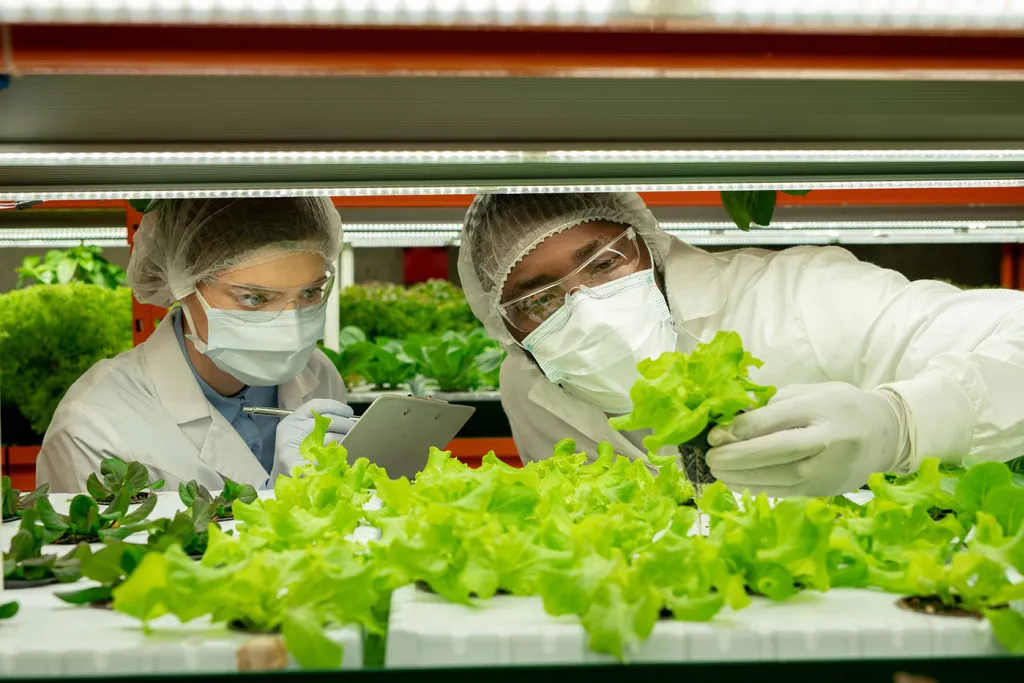
IMAGES
VIDEO
COMMENTS
The SBIR/STTR programs are an important source of early-stage technology funding for small businesses. Learn how the SBIR/STTR programs have helped R&D-focused entrepreneurs, and advanced research and development in a wide variety of technology areas. Read our annual report or search award data for more information.
Through the Small Business Innovation Research (SBIR) and Small Business Technology Transfer (STTR) programs, America's Seed Fund awards non-dilutive funding to develop your technology and chart a path toward commercialization. The federal government invests in your solution and gives you the freedom to run your business according to your vision.
Learn About SBIR. EPA is one of 11 federal agencies that participate in the SBIR Program established by the Small Business Innovation Development Act of 1982. EPA issues an annual solicitation for proposals from U.S. small businesses to develop and commercialize innovative technologies that address the Agency's mission.
The Small Business Innovation Research (SBIR) and Small Business Technology Transfer (STTR) programs are highly competitive programs that encourage domestic small businesses to engage in Federal Research/Research and Development (R/R&D) with the potential for commercialization.
The Small Business Innovation Research (or SBIR) program is a U.S. government funding program, coordinated by the Small Business Administration, intended to help certain small businesses conduct research and development (R&D). Funding takes the form of contracts or grants. The recipient projects must have the potential for commercialization and must meet specific U.S. government R&D needs.
Address U.S. Department of Energy SC-29/Germantown Building 1000 Independence Ave., SW Washington, DC 20585. Phone Tel (301) 903-5707. EmailSend us a message. [email protected]. Join Mailing List.
The Small Business Technology Transfer (STTR) program expands funding opportunities in the federal innovation arena. Central to the program is the expansion of the public/private sector partnership to include joint venture opportunities between small businesses and nonprofit research institutions. The unique feature of the STTR program is the ...
For decades, the Small Business Innovation Research (SBIR) program has provided federal funding to small businesses for technology development and commercialization. In fiscal year (FY) 2022, the 11 participating federal agencies made over 5,000 SBIR awards to small businesses valued at nearly $4 billion.
Tutorial 1 WHAT IS THE PURPOSE OF THE SBIR & STTR PROGRAMS? Back to Tutorials. The program is also occasionally framed as seed capital for early-stage R&D with commercialization potential: The awards are comparable in size to angel investments in the private sector. and indicate the acceptance of greater risk in support of agency missions.
For additional information on the DOE SBIR/STTR Programs . . . Please contact the DOE SBIR/STTR Programs Office by phone at 301-903-5707 or by email at [email protected]. Read more about Small Business Innovation Research (SBIR) and Small Business Technology Transfer (STTR)
The Small Business Innovation Research (SBIR) Program is a highly competitive three-phase award system which provides qualified small business concerns with opportunities to propose innovative ideas that meet the specific research and research and development needs of the federal Government. The SBIR program at the Department of Education is ...
The Small Business Innovation Research (SBIR) program, created in 1982 through the Small Business Innovation Development Act and reauthorized in 2011, is one of the largest public-private partnerships in the United States. The SBIR program encourages U.S. small businesses with fewer than 500 employees to provide quality research and to develop new processes, products and technologies in ...
SBIR is a highly competitive program that encourages small business to explore their technological potential and provides the incentive to profit from its commercialization. By including qualified small businesses in the nation's R&D arena, high-tech innovation is stimulated and the United States gains entrepreneurial spirit as it meets its specific research and development needs.
Small Business Innovation Research (SBIR): Established in 1982, the mission of the SBIR program is to stimulate technological innovation in the U.S. economy through the investment of federal research and development (R&D) funds into innovative high-tech US small businesses. The SBIR statute requires federal agencies with extramural R&D budgets ...
WASHINGTON - Administrator Isabella Casillas Guzman, head of the U.S. Small Business Administration and voice for America's 33 million small businesses in President Biden's Cabinet, released the following statement today after the House voted to reauthorize funding for the Small Business Innovation Research (SBIR) program: "Today's Congressional vote demonstrates strong bipartisan ...
The SBIR Program was established by Congress in 1982 to fund research and development (R&D) by small businesses of 500 or fewer employees. The STTR Program was established in 1992 to fund cooperative R&D projects with small businesses and non-profit U.S. research institutions, such as universities. Eleven federal agencies participate in the ...
The Small Business Innovation Research (SBIR) Program at the U.S. Department of Education (ED) is administered out of its research office, the Institute of Education Sciences (IES). ED/IES SBIR provides up to $1.25M in funding in 2 phases: Phase I for $250,000 for 8-months for rapid prototype development and evaluation of new education ...
Understand the basics of the Small Business Programs, including: The Small Business Innovation Research (SBIR) and Small Business Technology Transfer (STTR), collectively the Small Business Programs, are also known as America's Seed Fund. By setting aside more than $1.3 billion from its Research & Development Funding specifically for our ...
The Small Business Innovation Research (SBIR) program is a highly competitive merit-based grant program that encourages U.S. small businesses to engage in federal Research/Research and Development (R/R&D), with the end goal of developing innovative and commercially-viable products or services. Including qualified small businesses in the nation ...
The SBIR and STTR programs are U. S. Government programs, intended to help certain small businesses conduct R&D. At DOE, funding takes the form of grants. Projects must have the potential for commercialization and meet specific DOE mission-specific R&D needs. The SBIR/STTR Programs Office works collaboratively with 13 program offices throughout ...
For questions, contact April Richards, SBIR Program Manager ([email protected]) or (202) 564-6462. Overview of the SBIR Program established by the Small Business Innovation Development Act of 1982. EPA issues annual solicitations for Phase I and Phase II research proposals from science and technology-based firms.
Today, the Biden-Harris Administration awarded nearly $5 million to 17 small businesses across nine states under the Small Business Innovation Research (SBIR) Program. The SBIR Phase I awards will fund research projects to explore the technical merit or feasibility of an innovative idea or technology for developing a viable product or service ...
The Department of Defense (DoD) Small Business Innovation Research (SBIR) and Small Business Technology Transfer (STTR) programs are Congressionally authorized small business set-asides established to support scientific excellence and technological innovation through investment of Federal research funds in critical American priorities to build a strong national economy.
Washington, D.C. -- The U.S. General Services Administration (GSA) today announced it is launching a pilot program to award and manage Small Business Innovation Research (SBIR) Phase III contracts. Awards will be made and managed by GSA's Office of Assisted Acquisition Services (AAS) during the pilot, which will run through September 2019.
NSF Small Business Innovation Research / Small Business Technology Transfer Phase I Programs (SBIR/STTR Phase I) ... responsibility under that section to certify that the individual is not a party to a Malign Foreign Talent Recruitment Program. The startup's or small business' research and development (R&D) must be performed within the ...
The Small Business Administration (SBA), through the SBIR/STTR Policy Directive, provides policy guidance for these programs. A main purpose of the legislation is to stimulate technological innovation and increase private sector commercialization among small business concerns and enable them to undertake and to obtain the benefits of research and development in order to maintain and strengthen ...
WASHINGTON - Today, Administrator Isabel Casillas Guzman, head of the U.S. Small Business Administration (SBA) and the voice in President Biden's Cabinet for America's more than 34 million small businesses, announced three new Cybersecurity Pilot Program Grant recipients will receive a total of $3 million in funding through the SBA's Cybersecurity for Small Business Pilot Program.